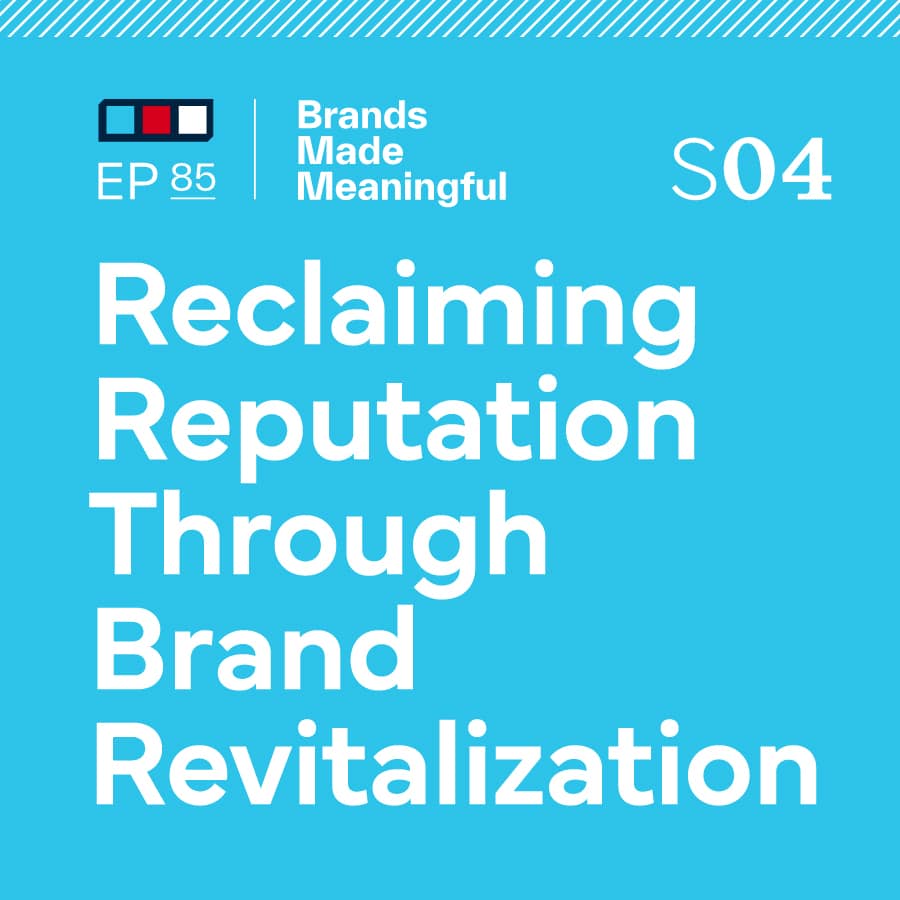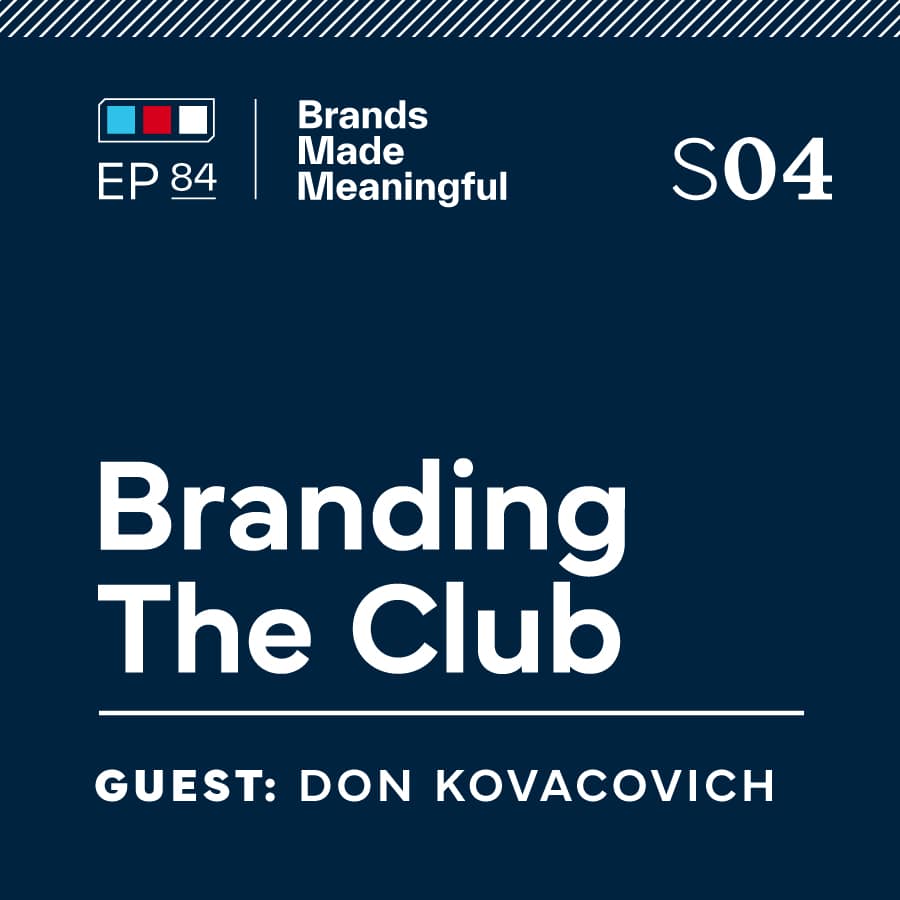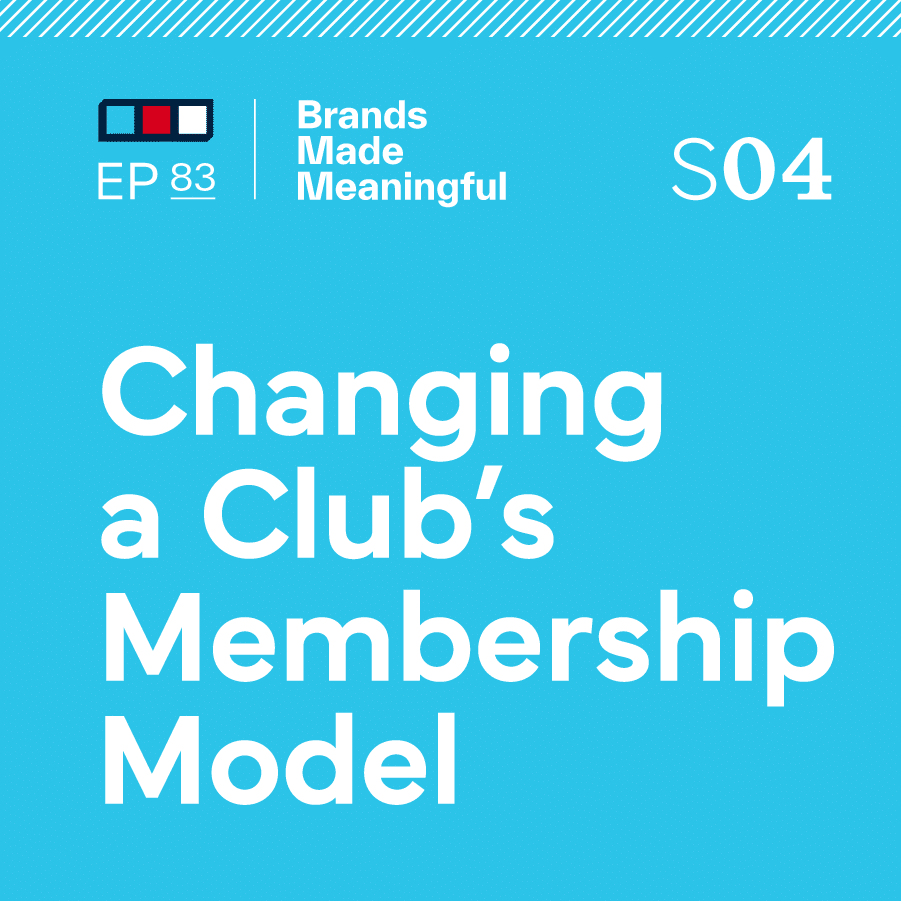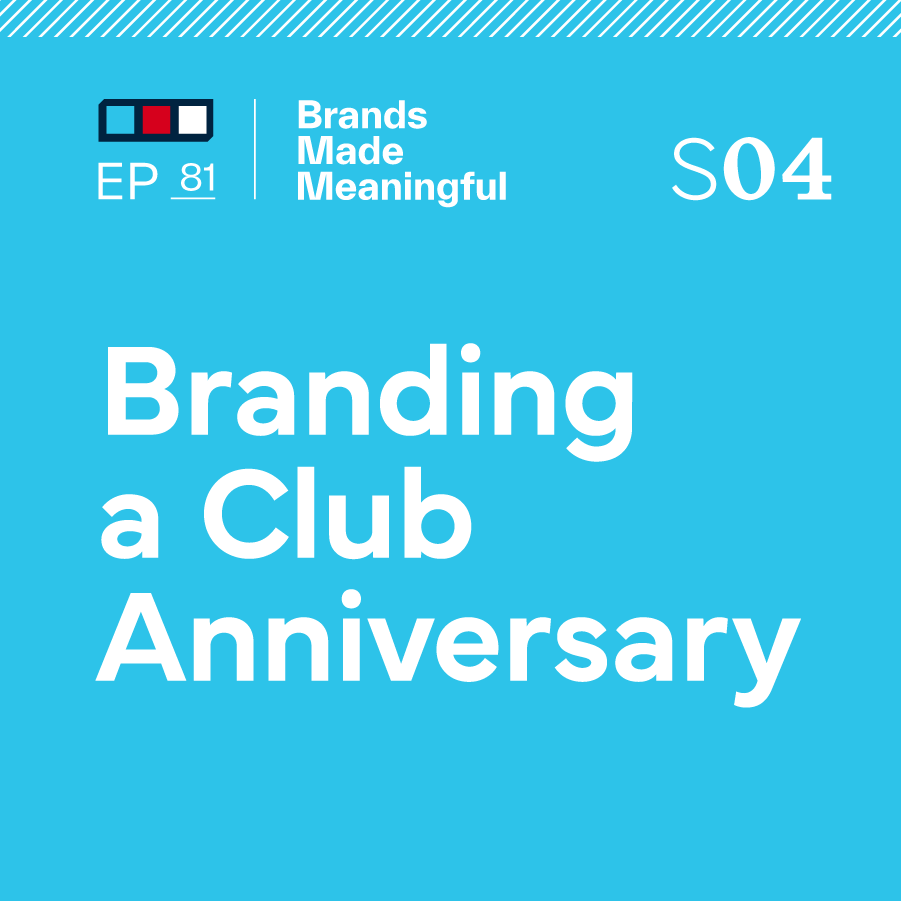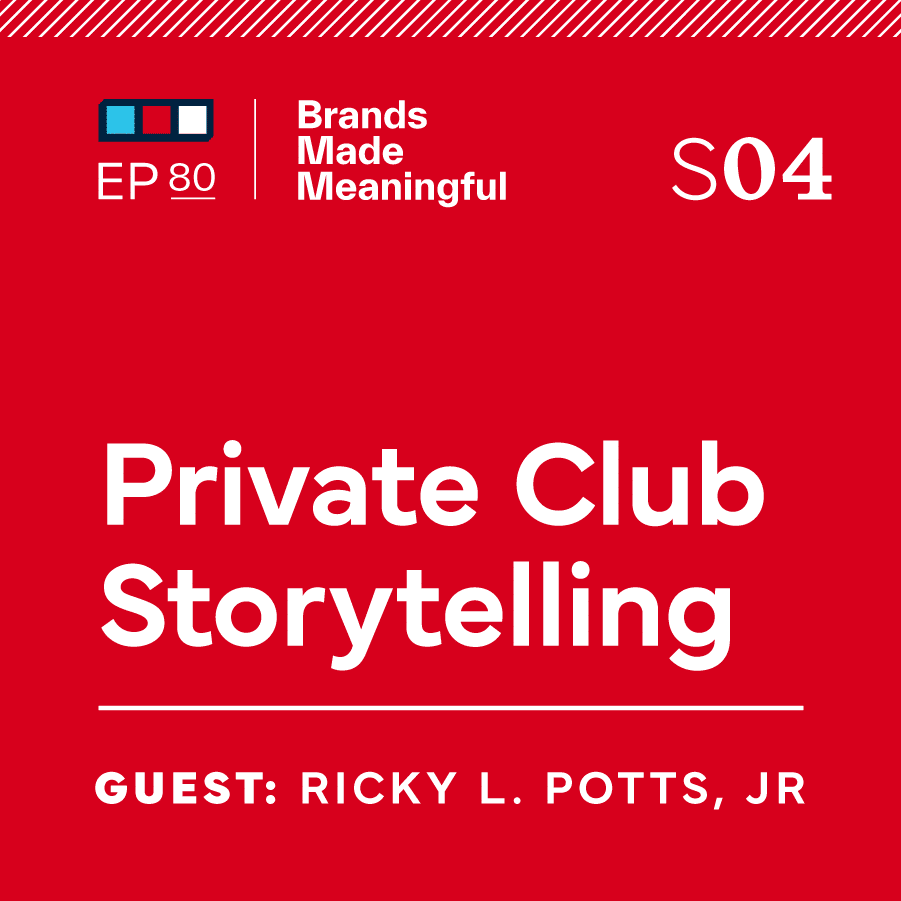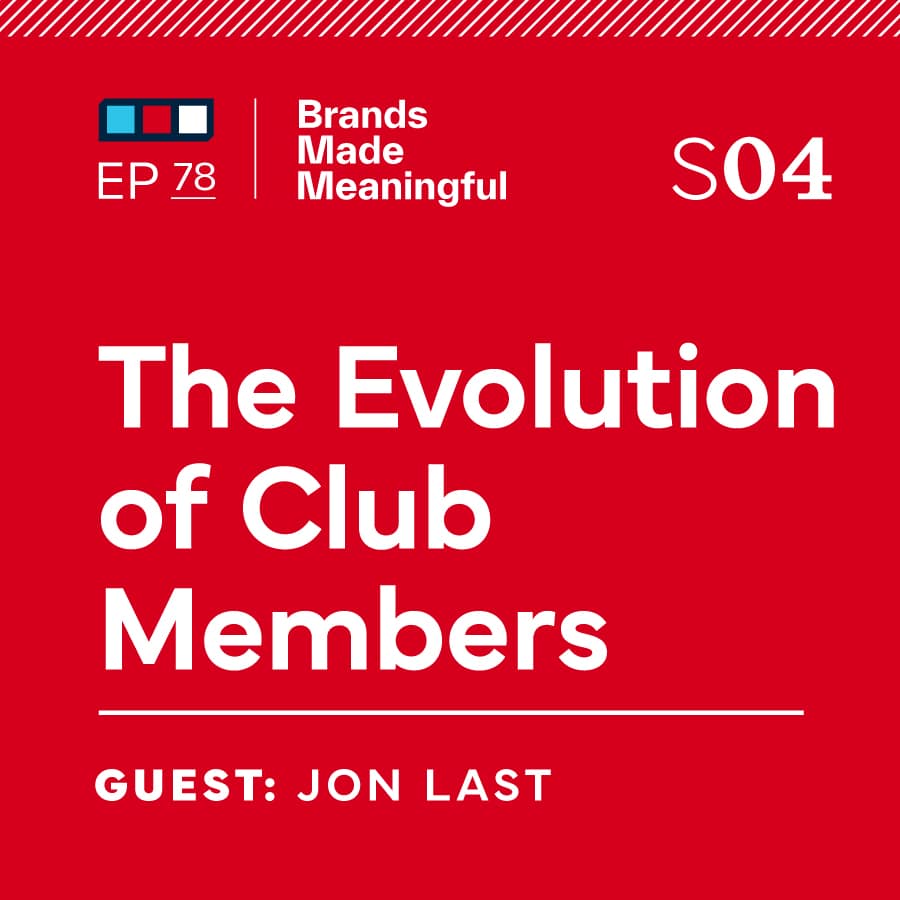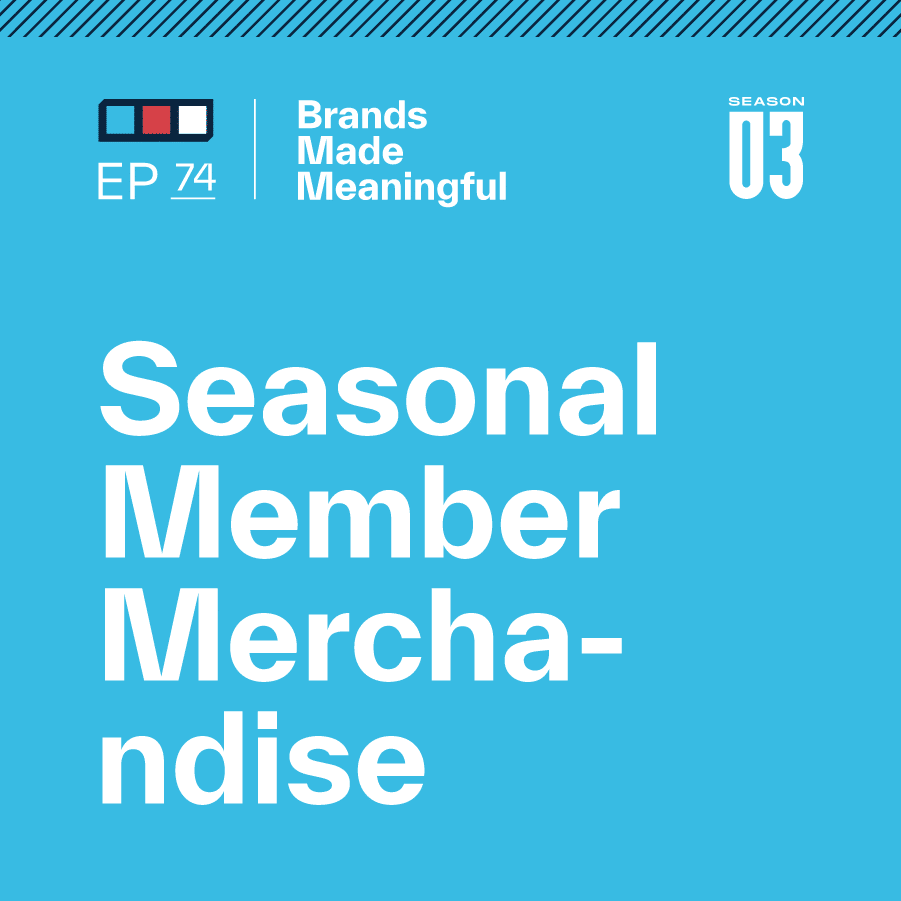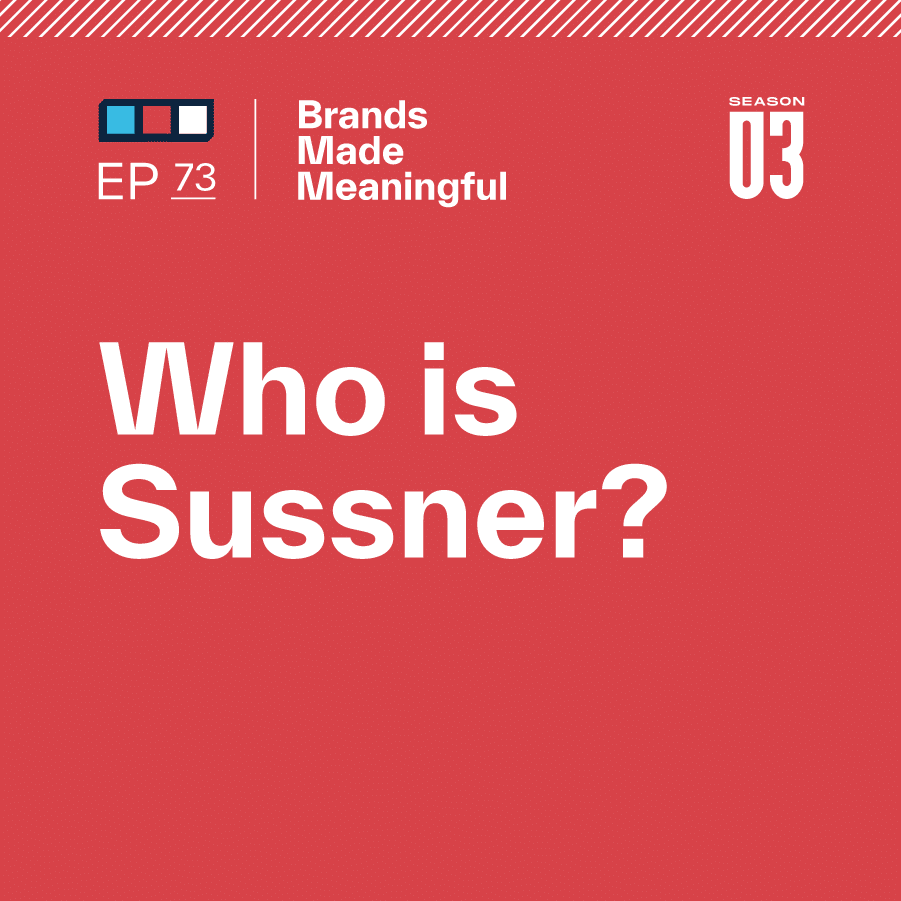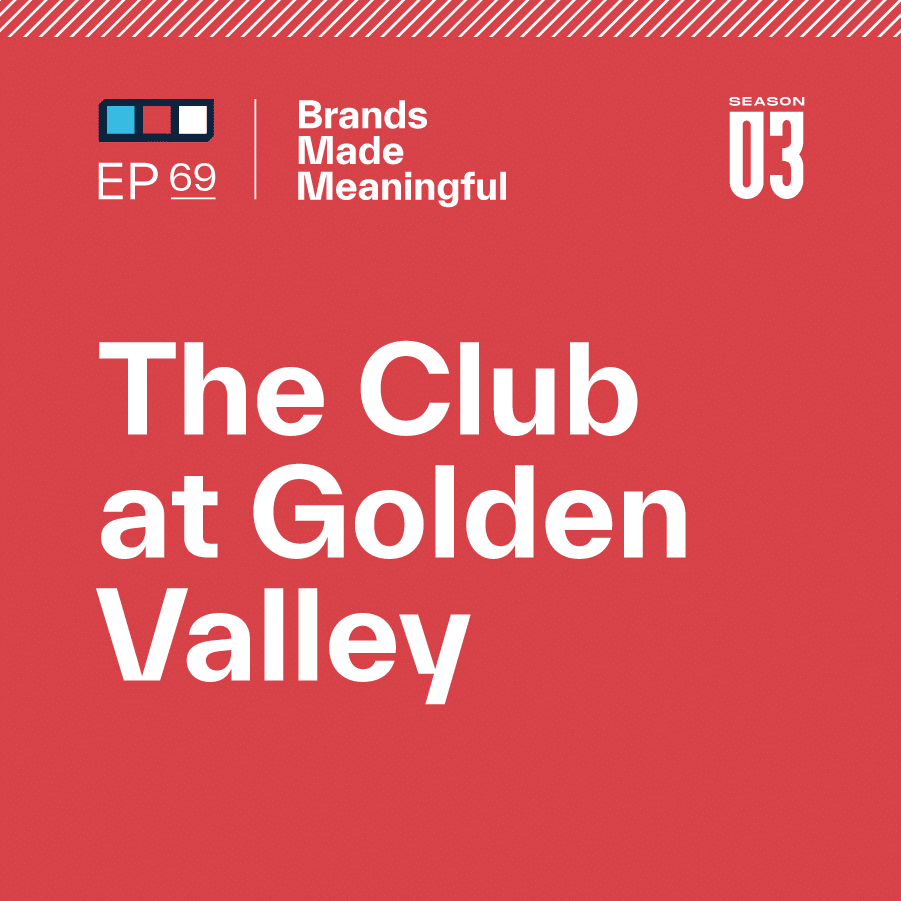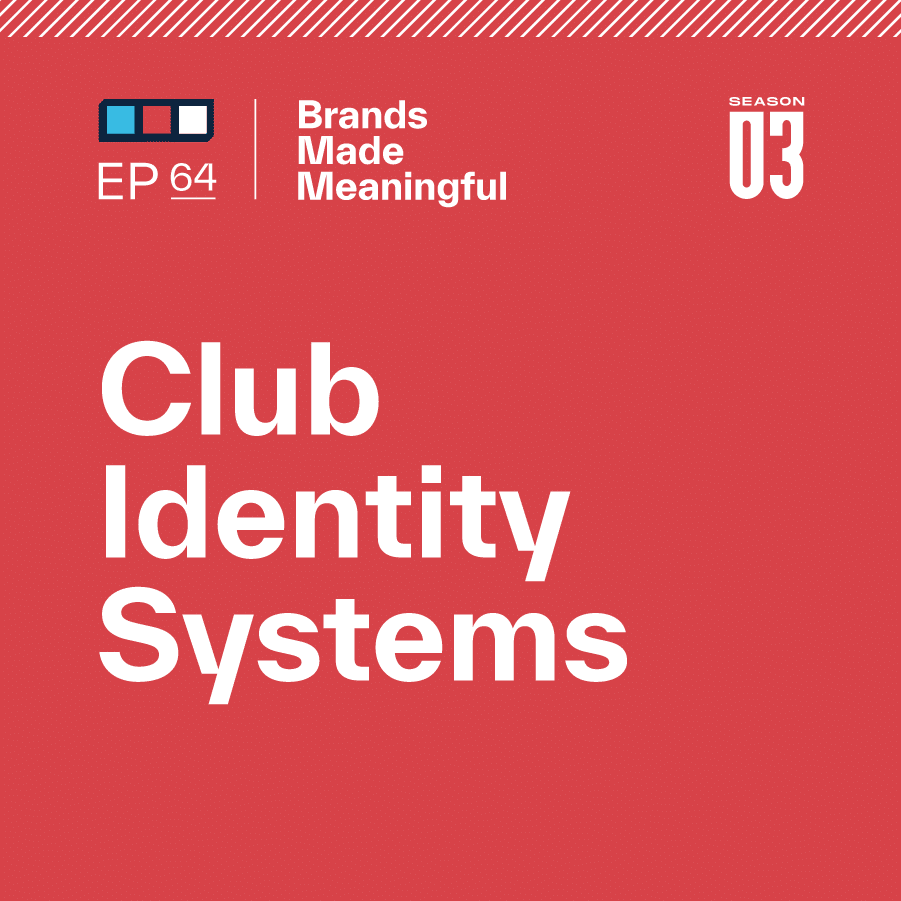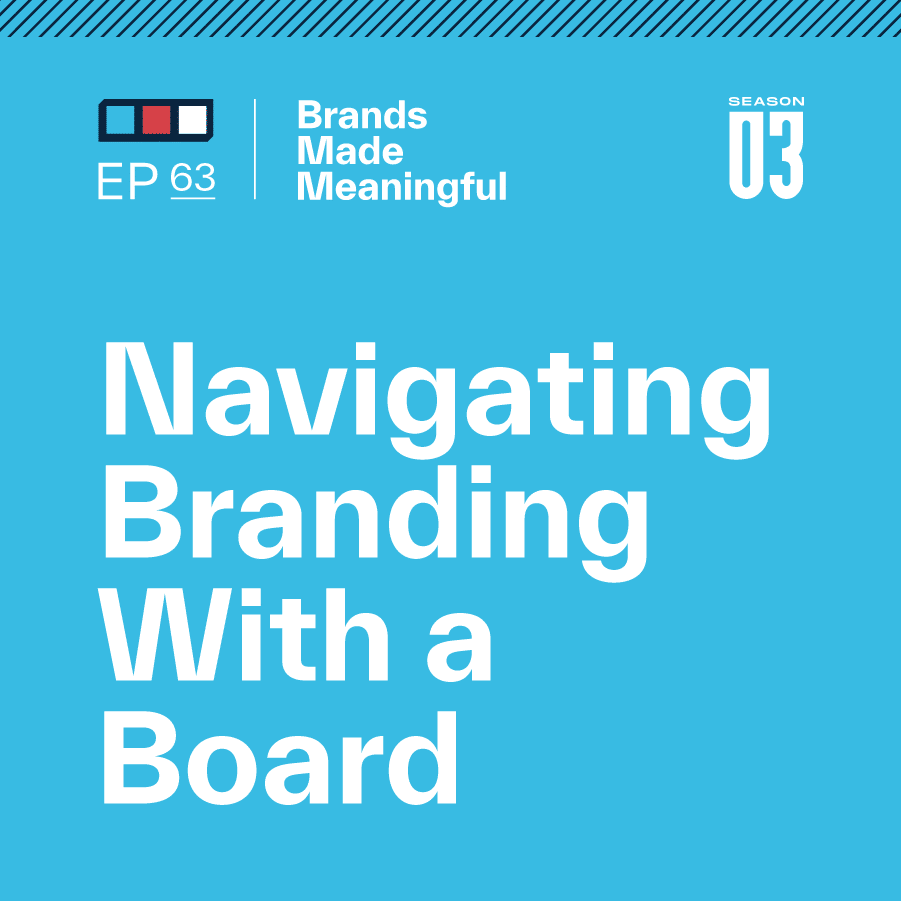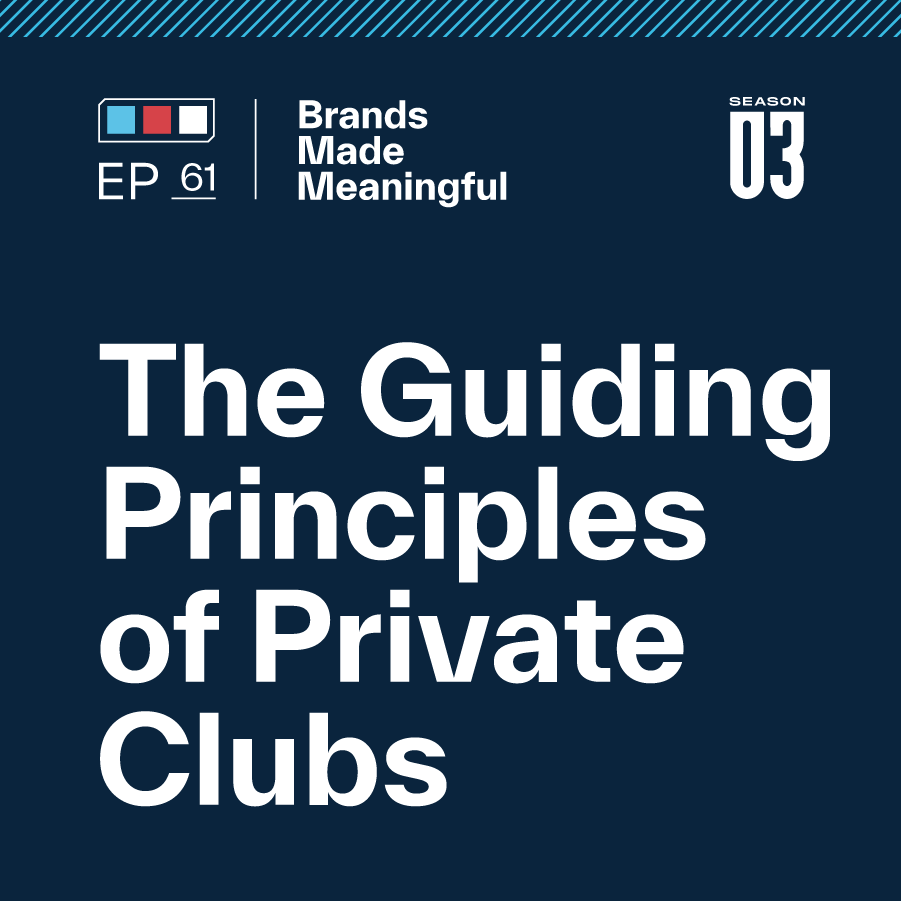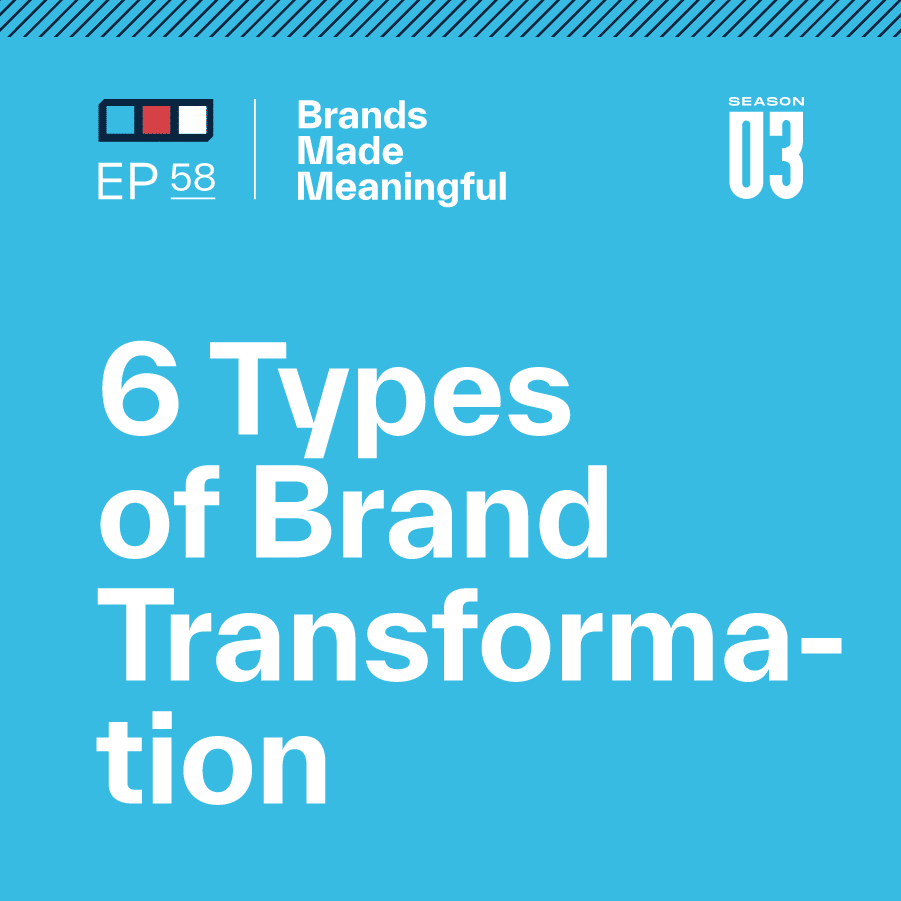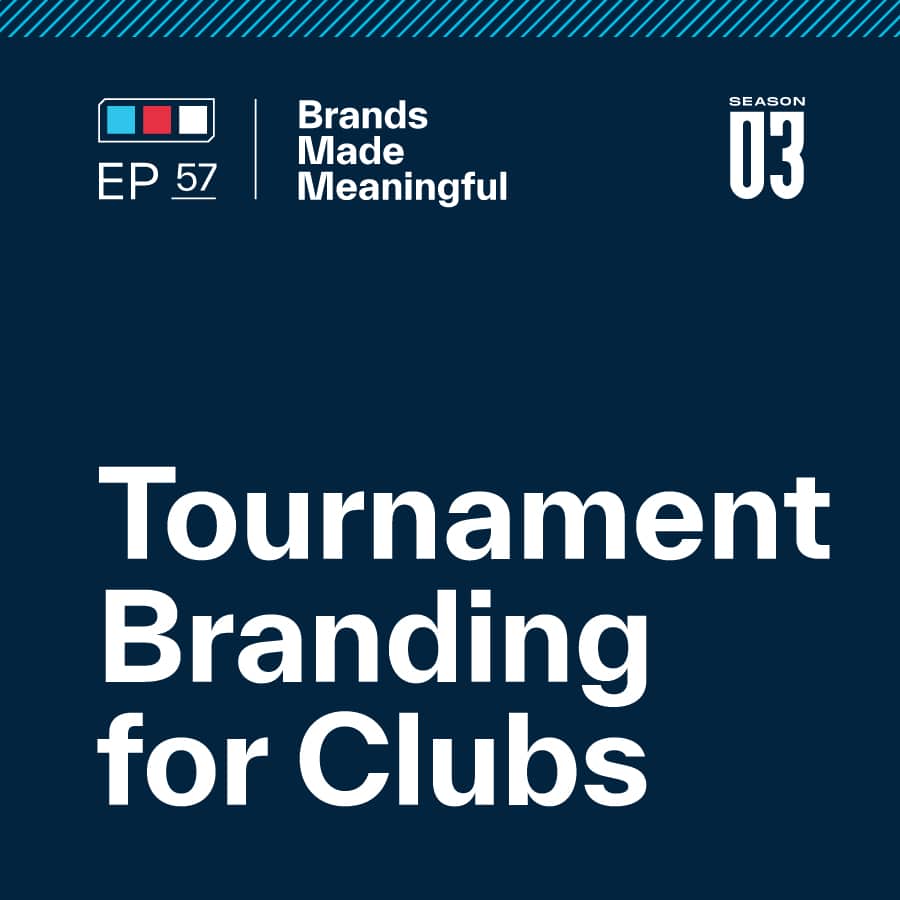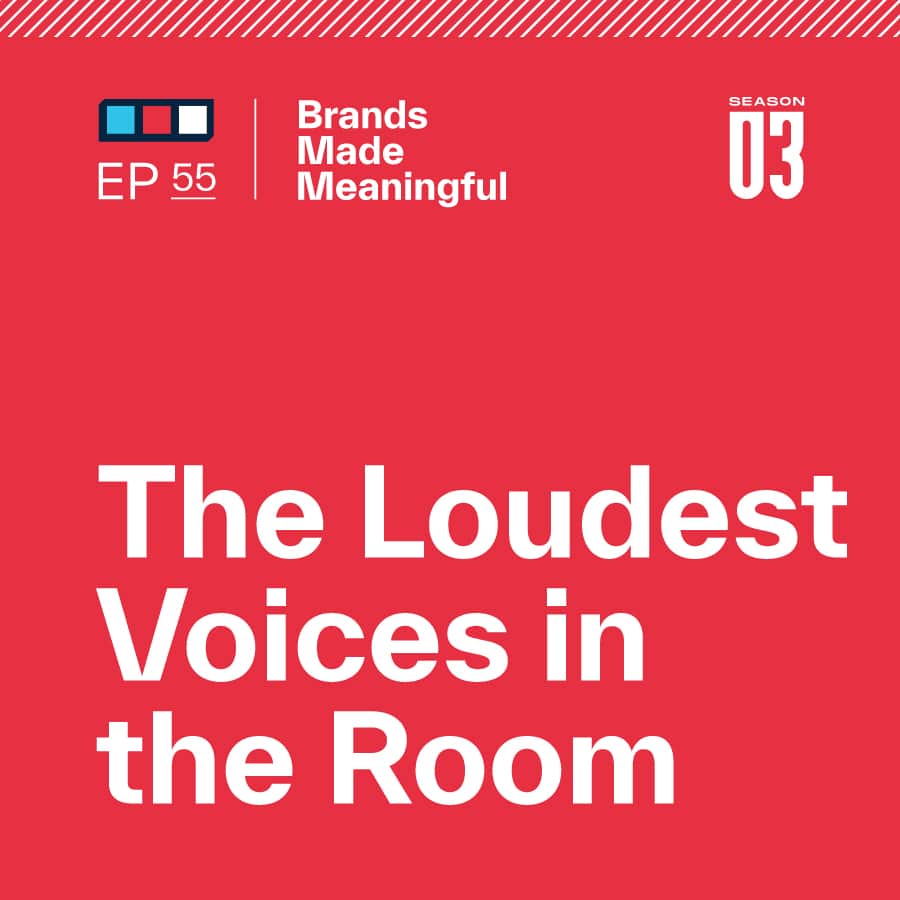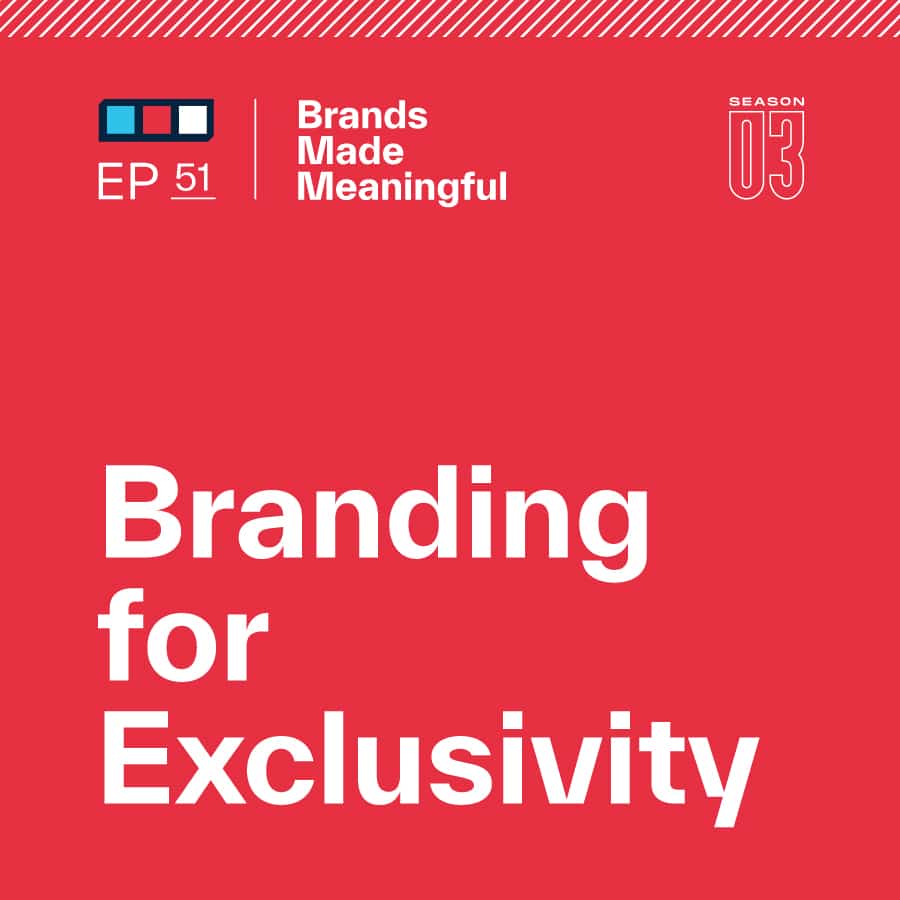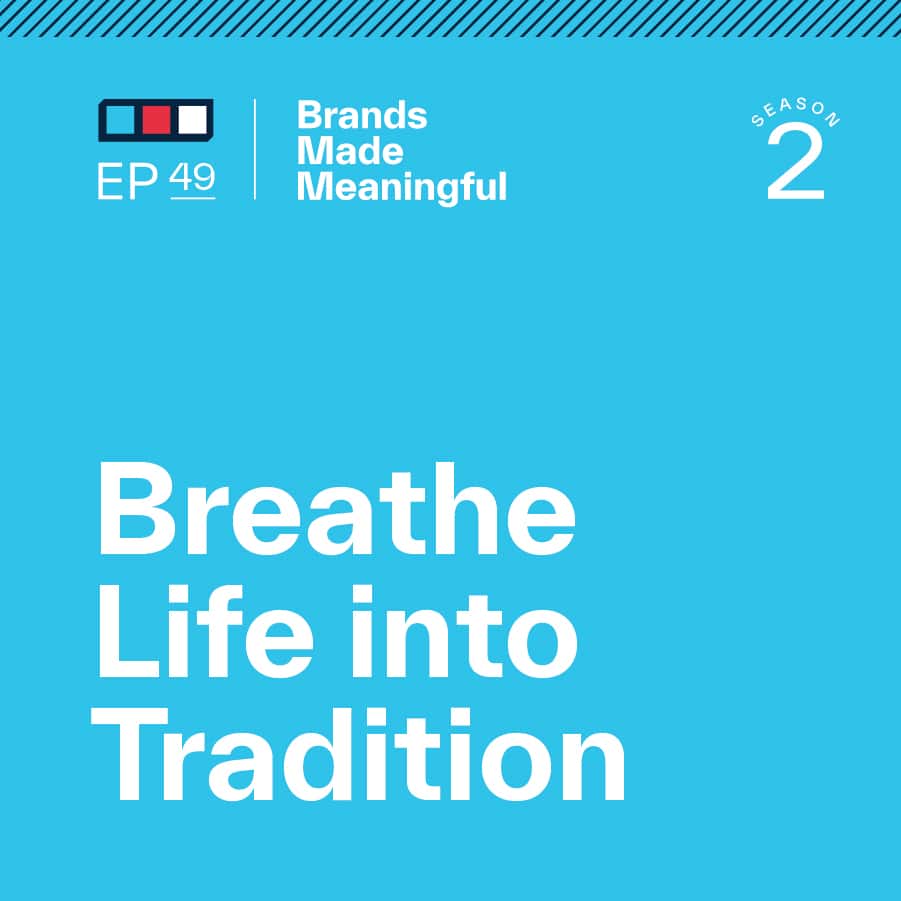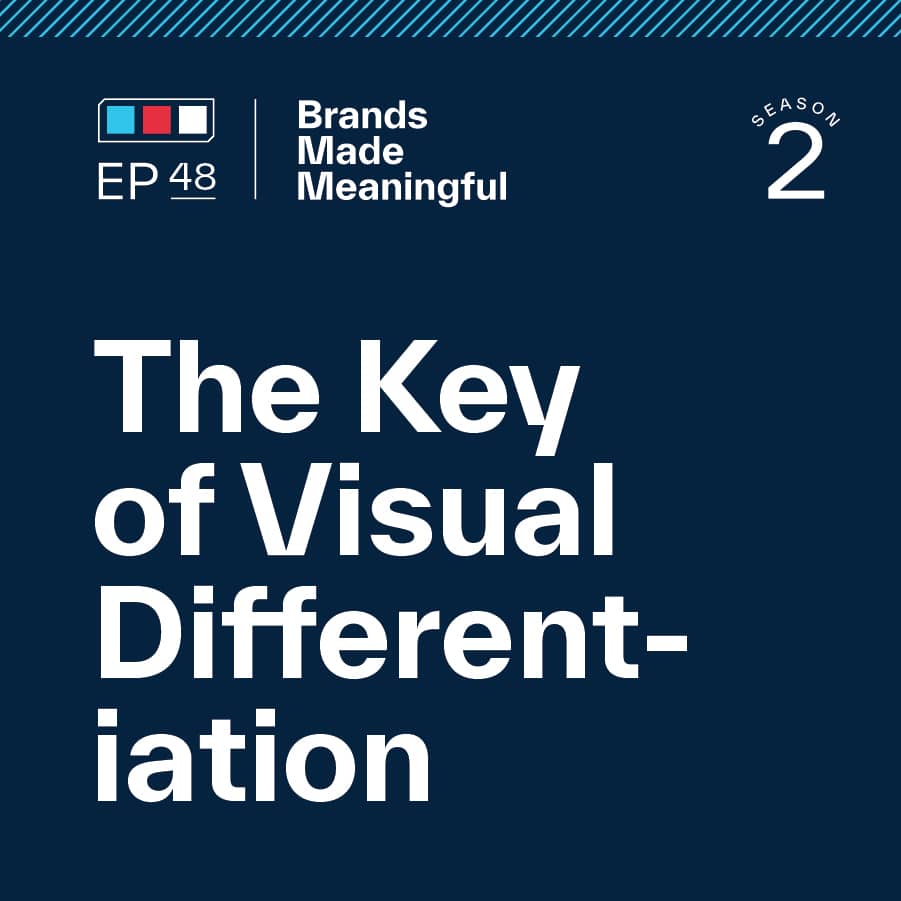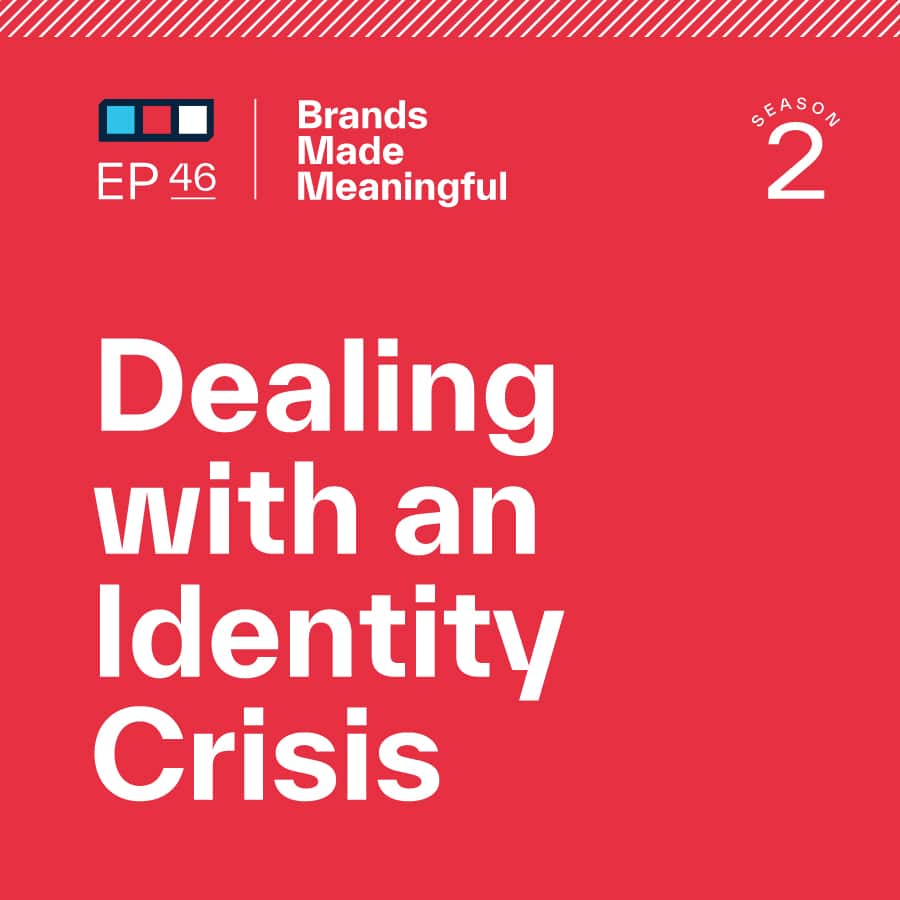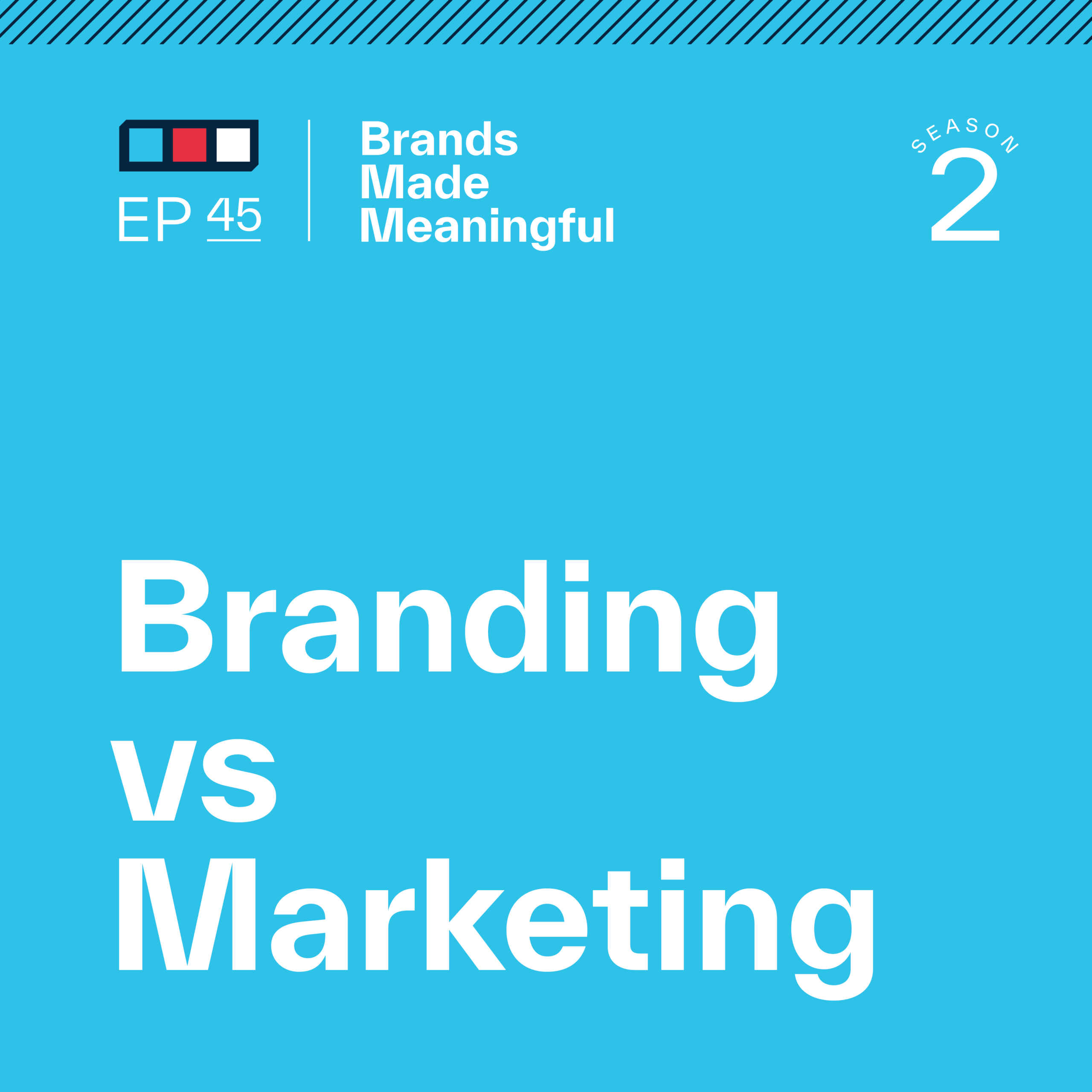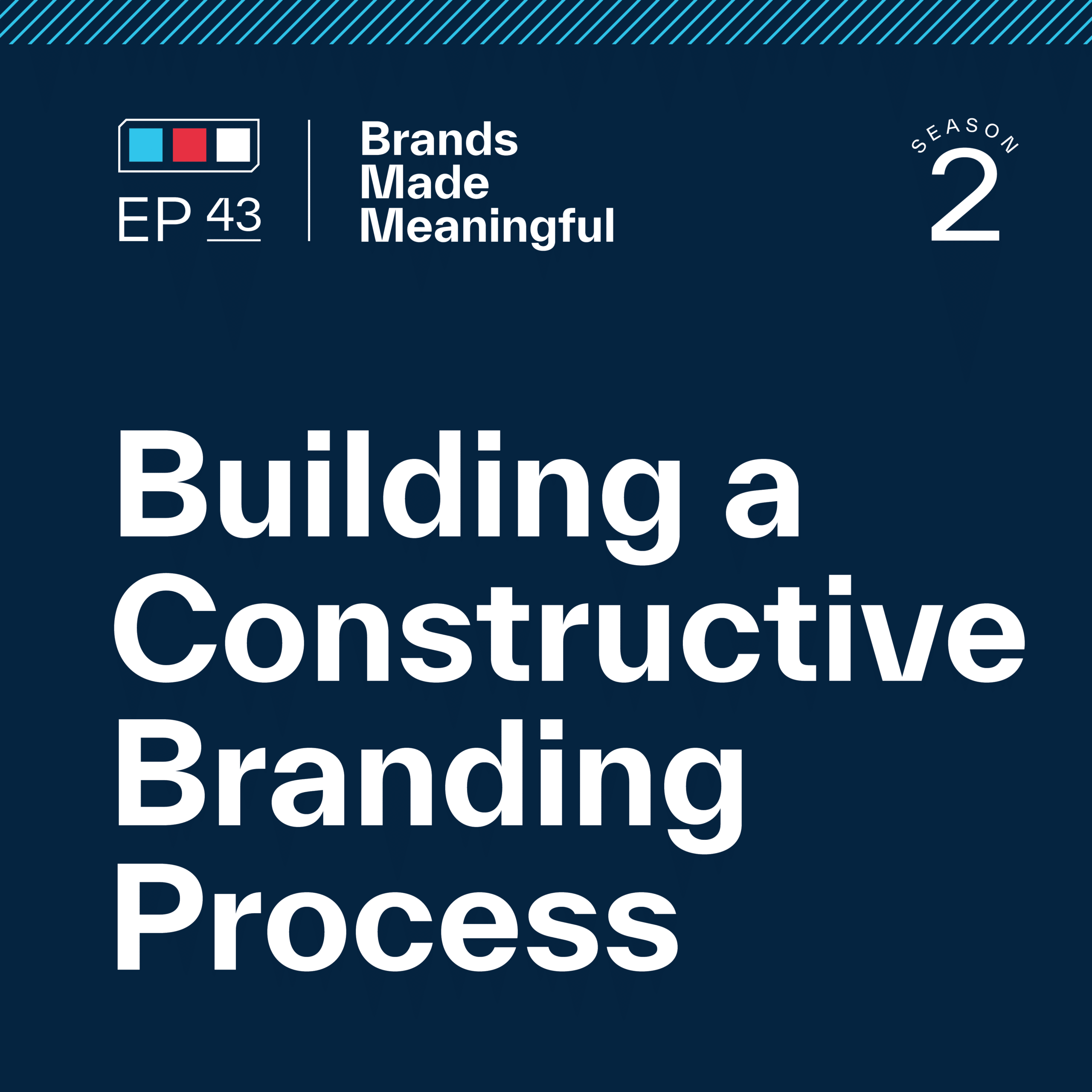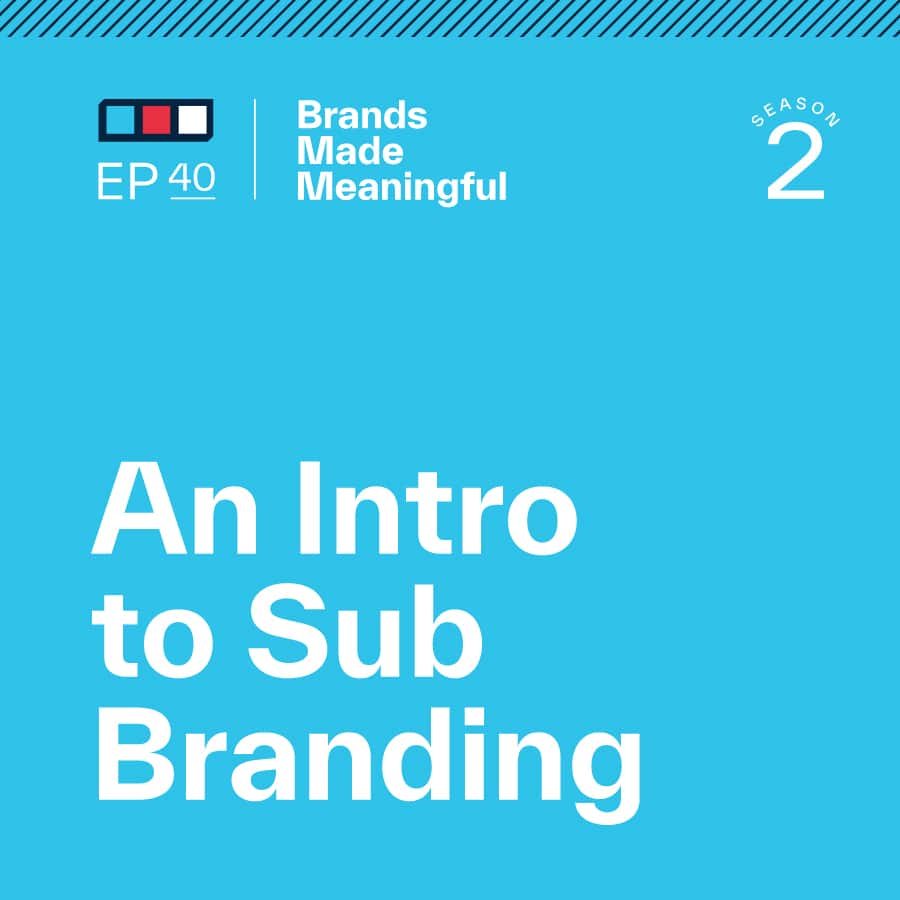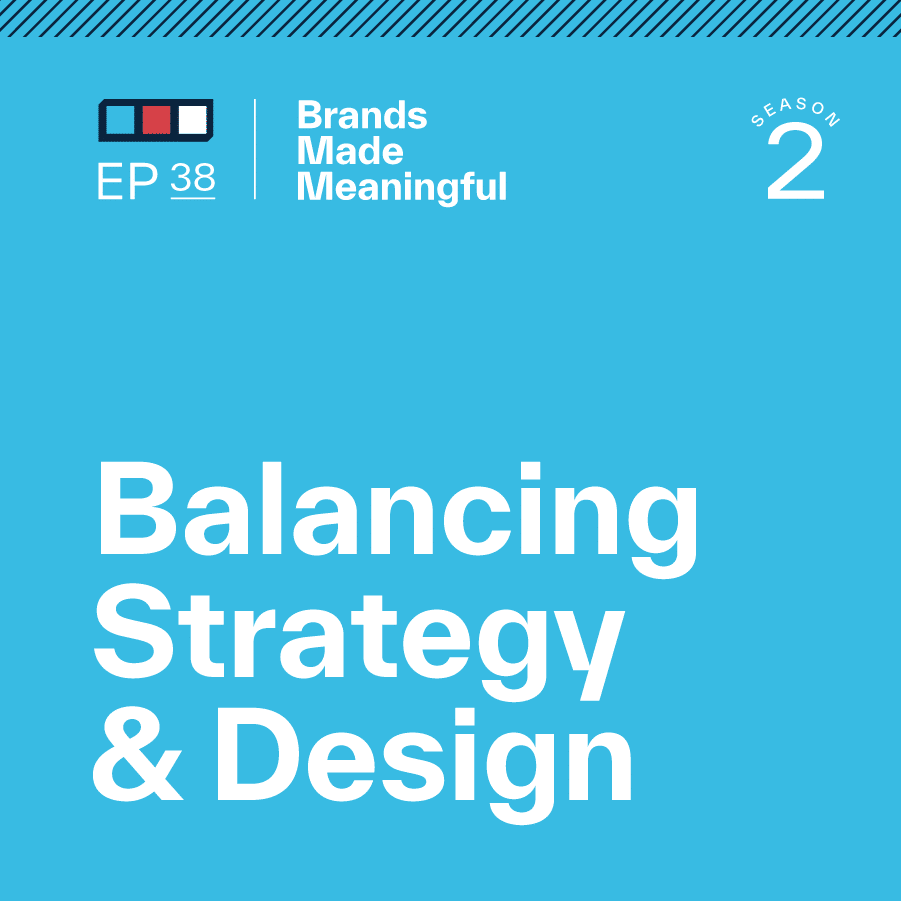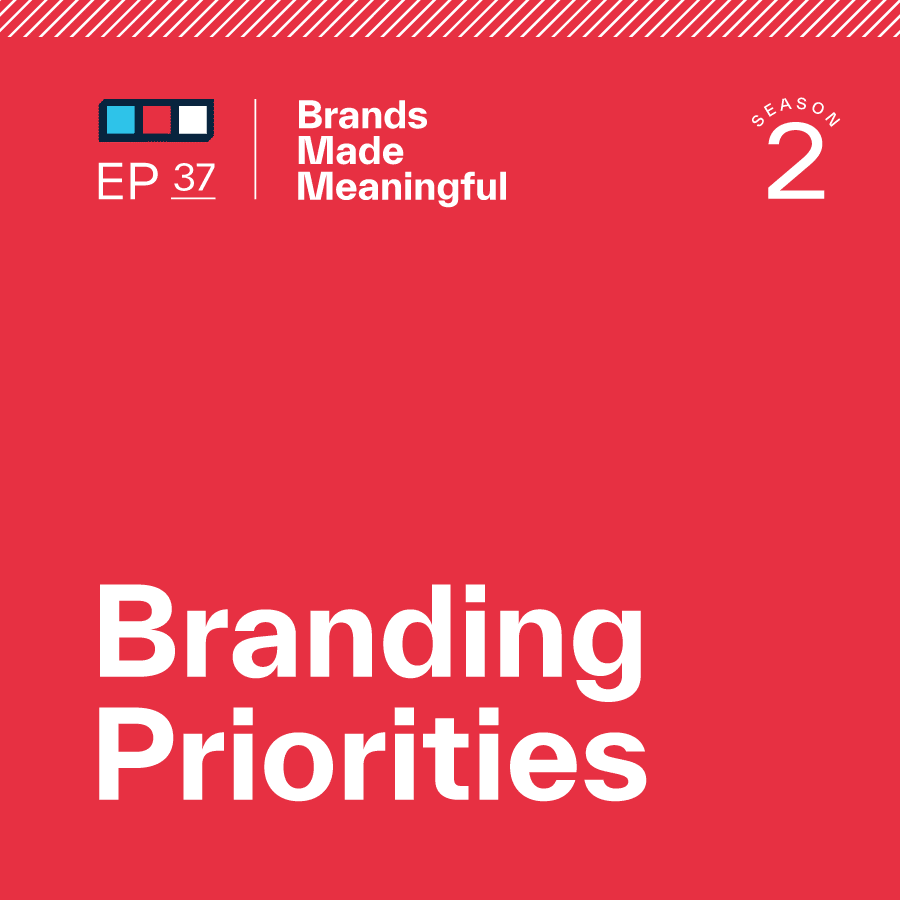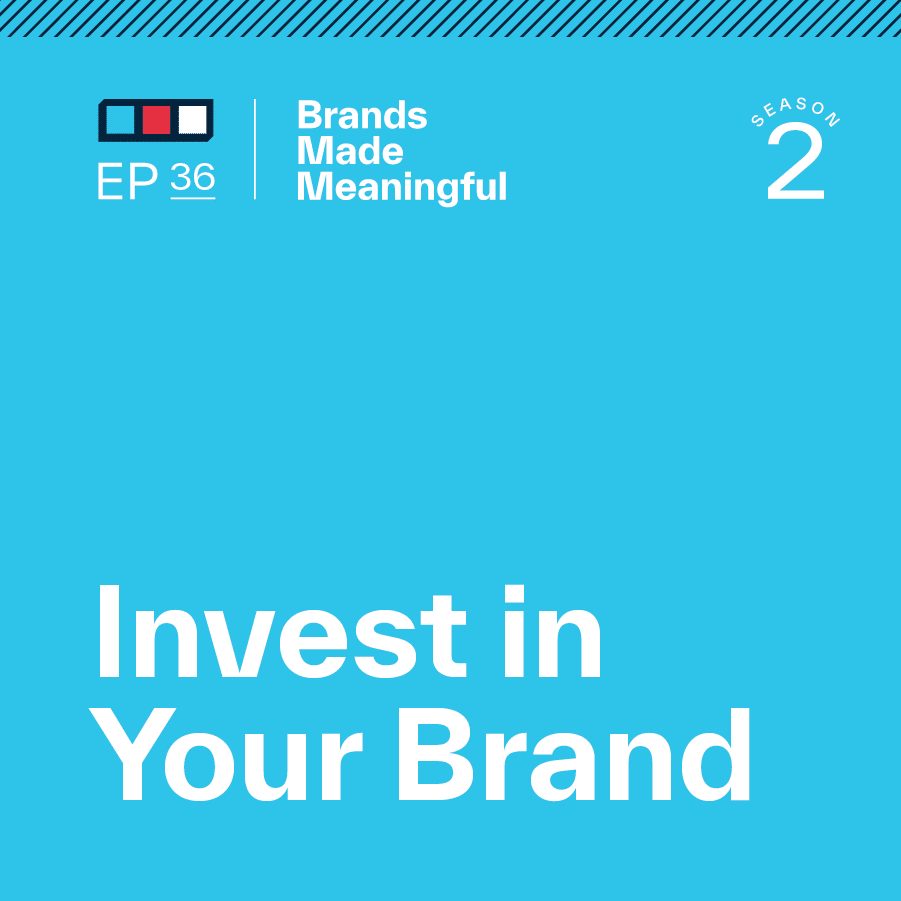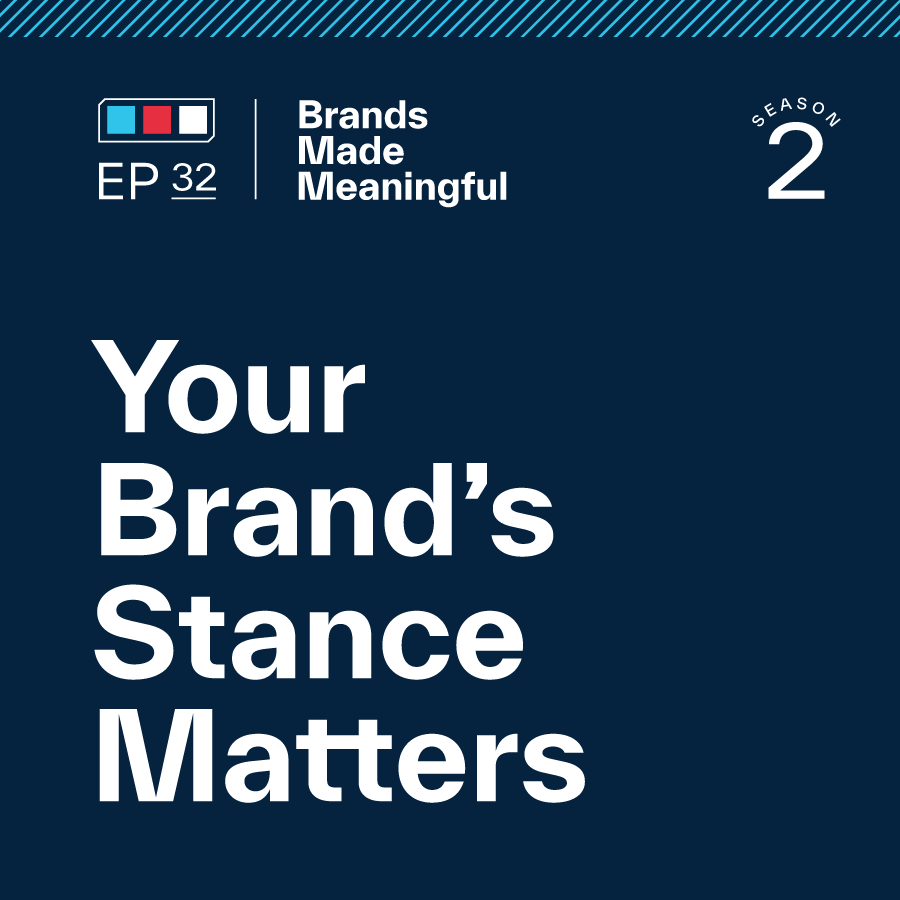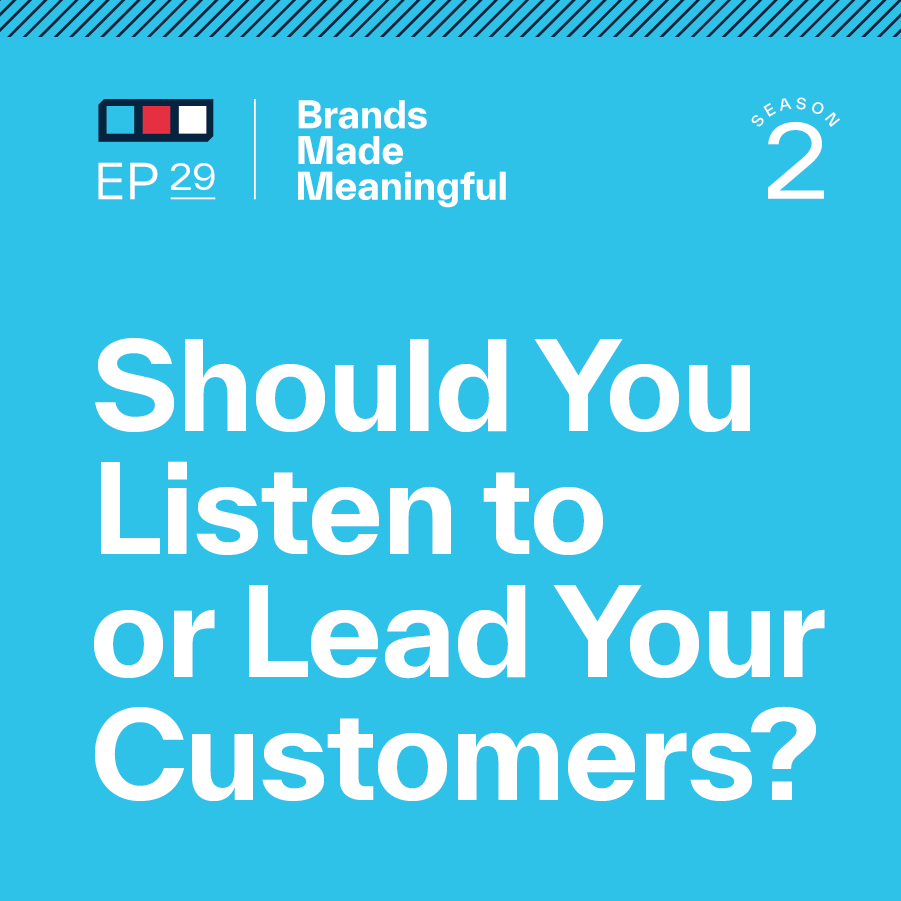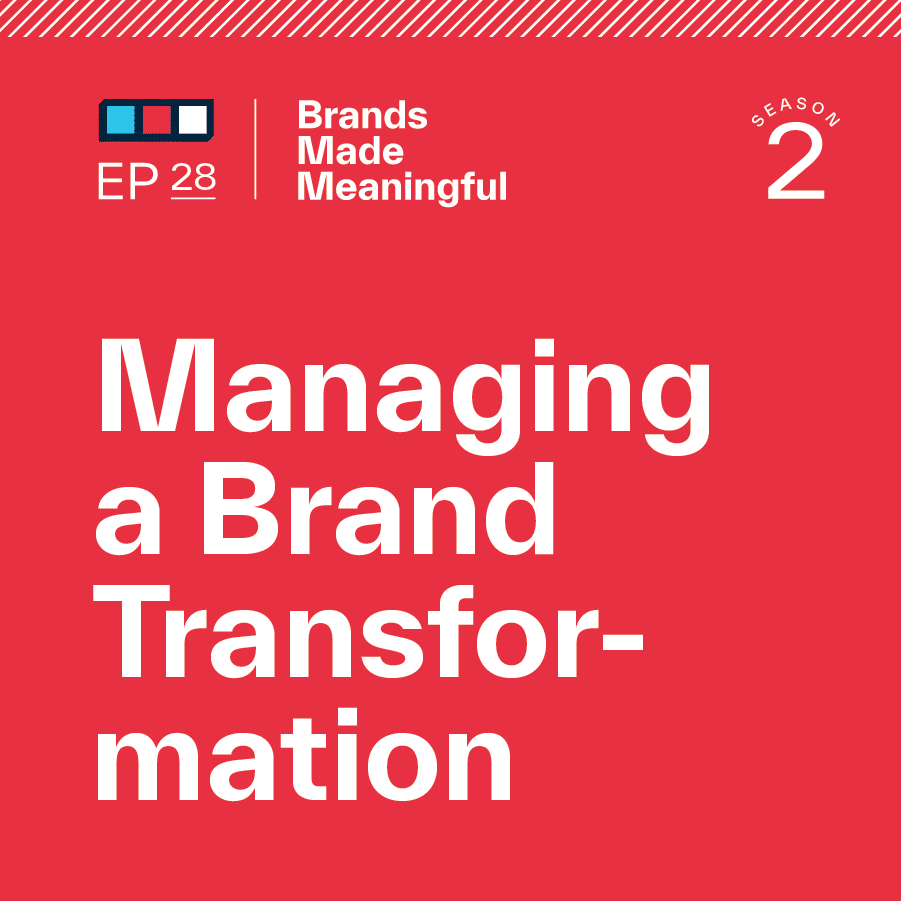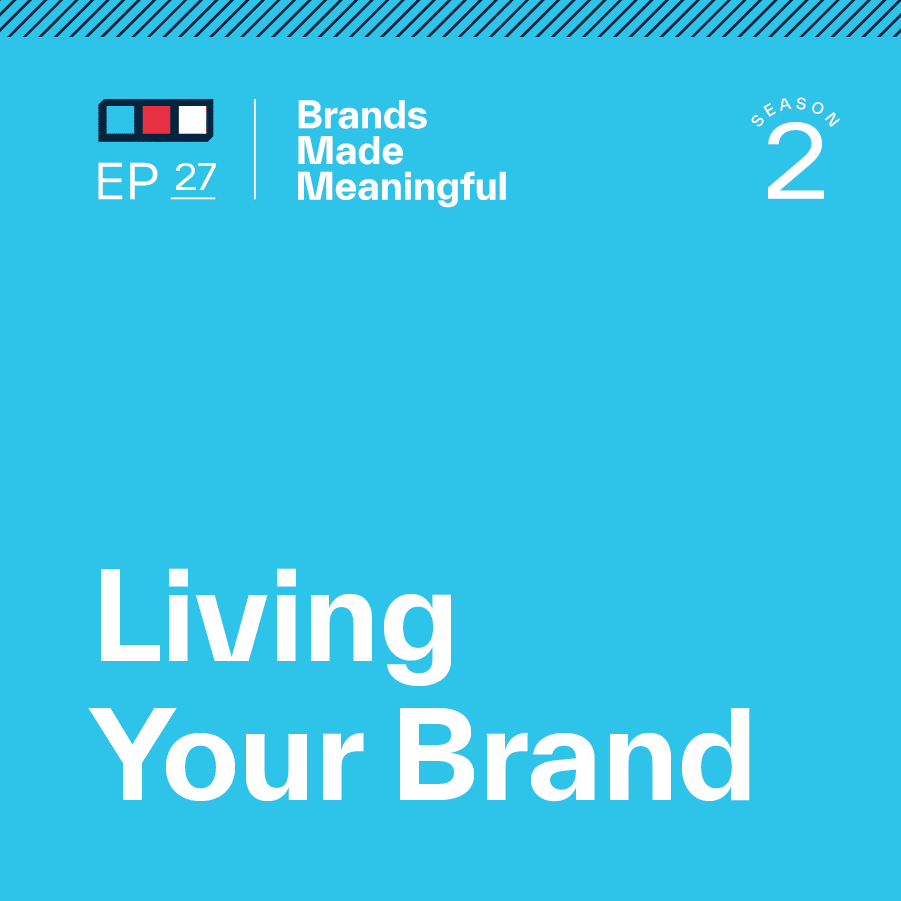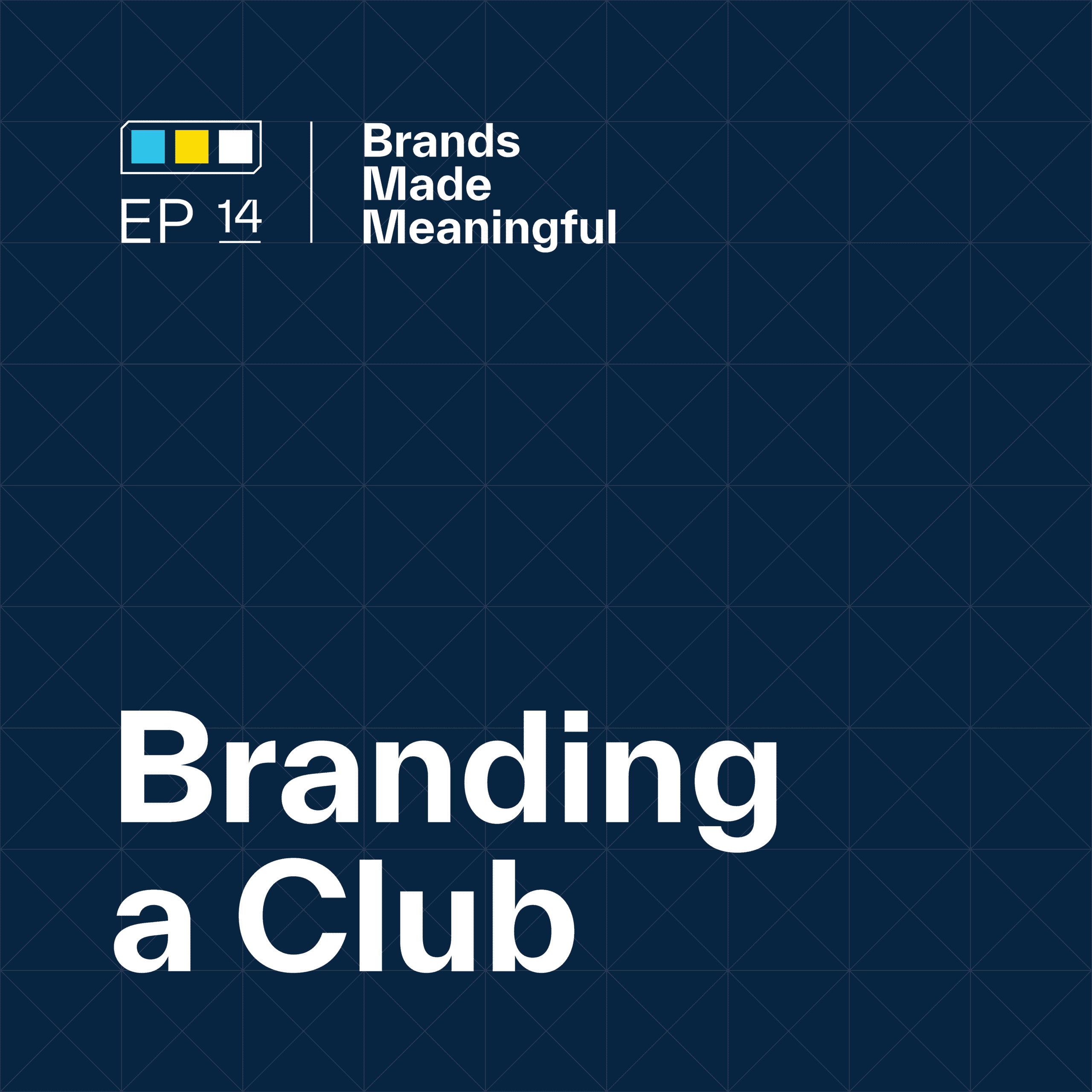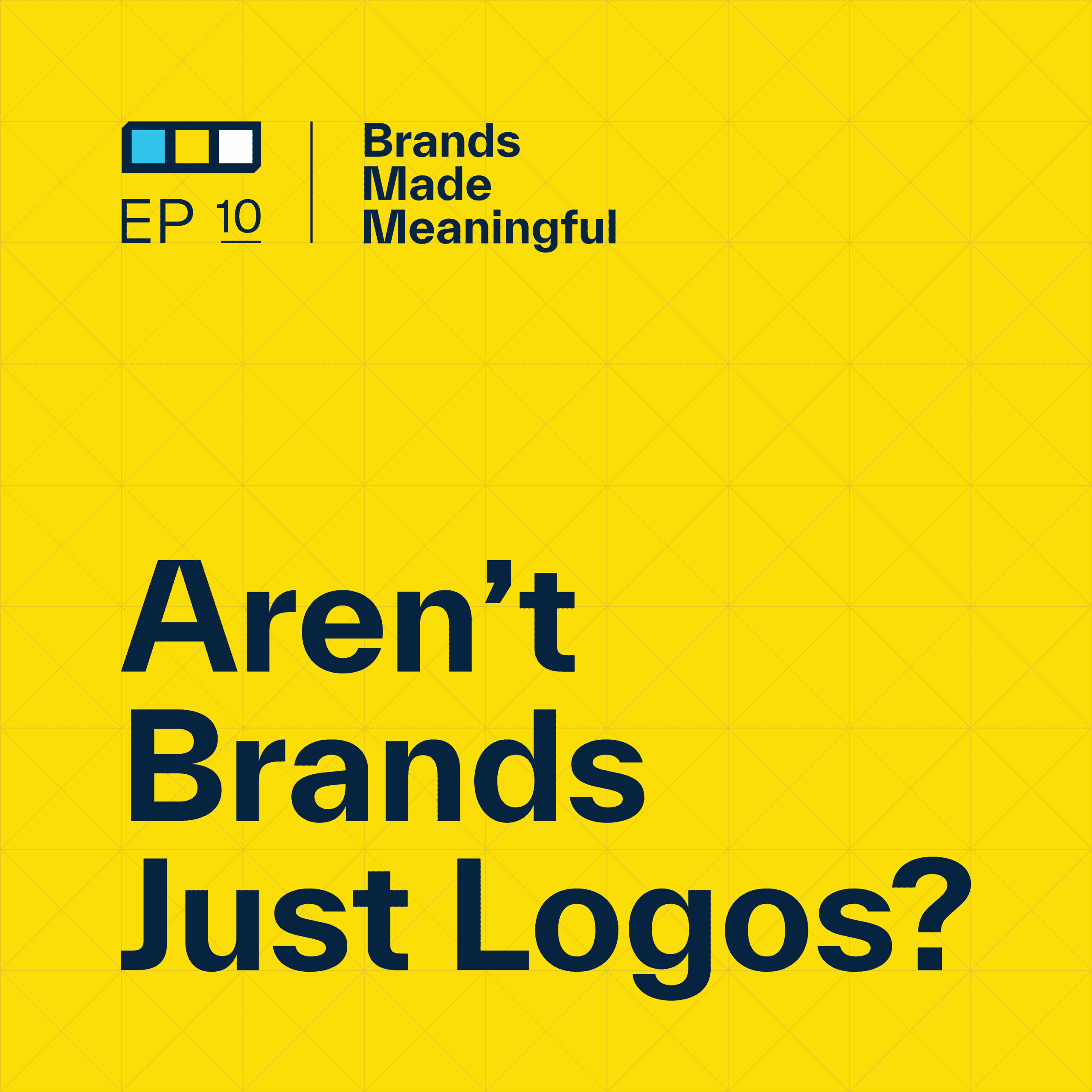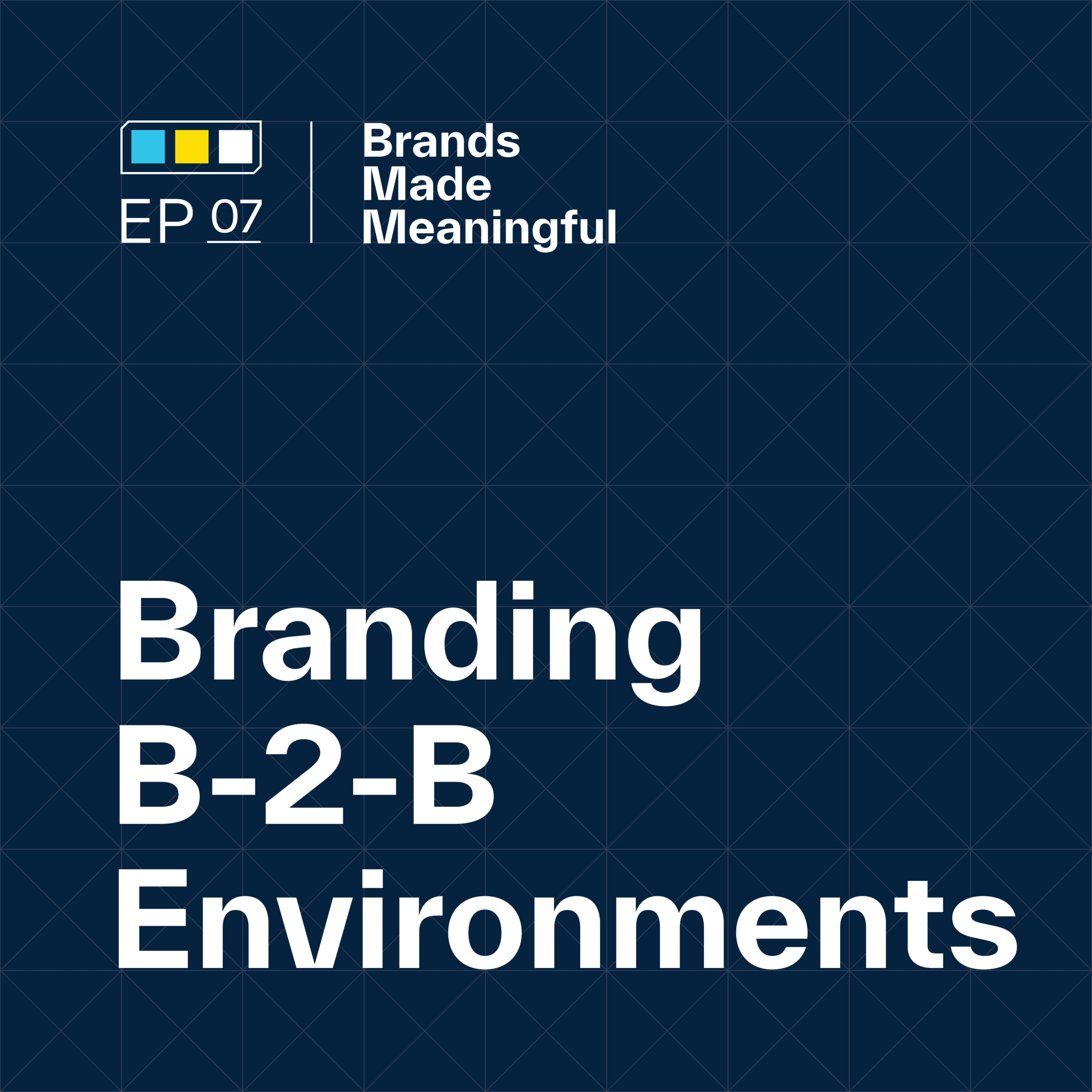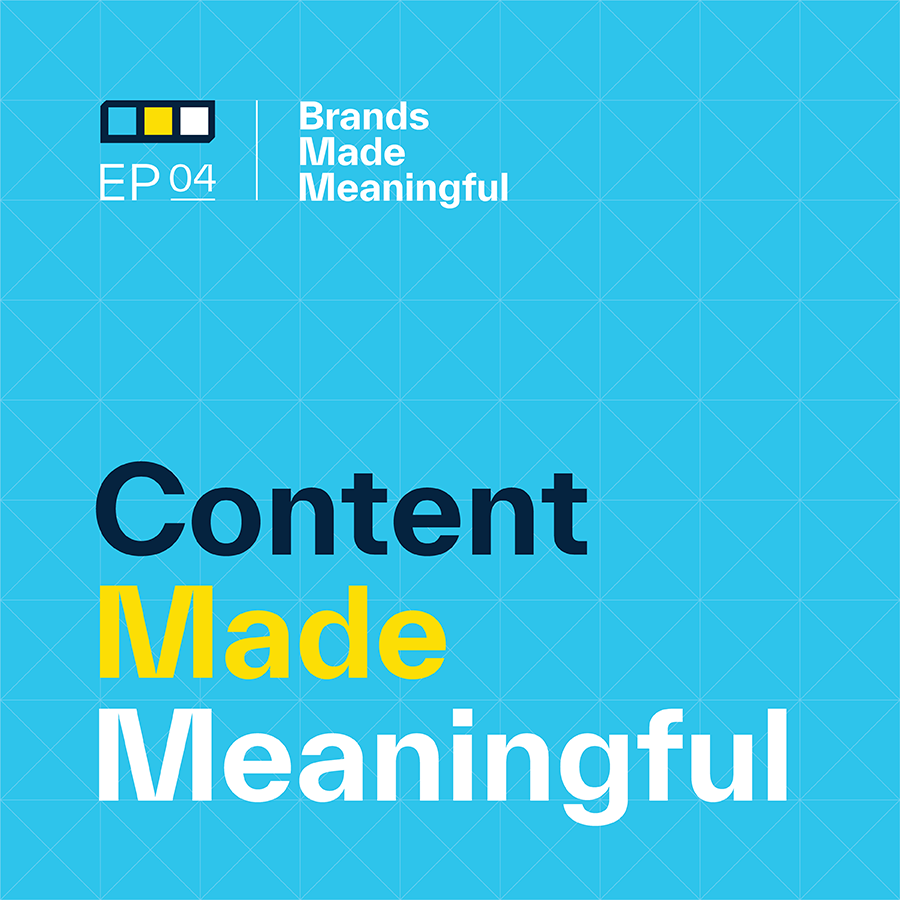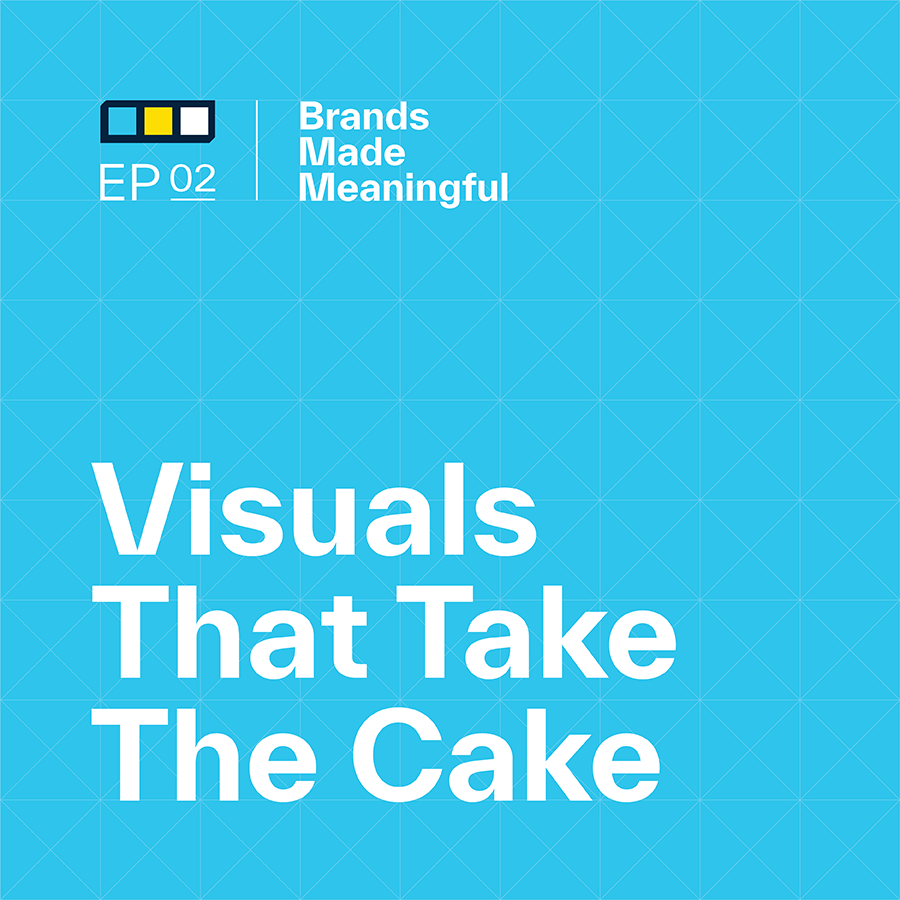EPISODE 44

Build Your Brand’s Foundation
Episode 44
A brand’s foundation is a critical element in being successful in the long-term.
EPISODE TRANSCRIPTION
It’s a core piece of what we do. It’s a core piece of the strategy portion of our work.
Tucker Welcome back to another episode of Brands Made Meaningful. We were talking about this right before we got on, and I said I can’t believe we haven’t had a conversation about Brand Foundation yet.
Expand Full Transcript
Derek We’ve covered components of this in quite a few previous podcasts. We refer to it all the time in some way, shape, or form, but it’s kind of long overdue. Maybe it’s a bit of an oversight to not just hit this full-on.
Tucker For people who don’t know or haven’t talked to us or worked with us, we talk about the brand foundation. It’s a portion of brand strategy for us. It is something that we believe are the core pieces of your brand. It’s your guiding principles. It’s things like your mission, vision, and purpose. We’ve had episodes in the past talking specifically about a vision, but we’ve never really talked about the big picture of how we’re going to use this and where its place is within the whole strategy and within the whole brand itself.
Derek Everybody’s heard about a mission statement or a vision statement. Most people are familiar with Simon Sinek, The Golden Circle, and Uncovering Your Why. But from EOS to Story Brand to Simon Sinek, to all of the other tools and ways that have approached this, we’ve never really quite found a model that made sense to us from a branding lens. So we had to put one together. What we landed on is basically how each of the pieces and components affect each other, work together, and leverage each other to ultimately make a brand’s foundation as strong as it possibly can be.
Tucker So here’s a little backstory, a little bit of why we got to this point. If you haven’t looked at the Simon Sinek Golden Circle or any of those TED Talks, the general problem that people have when trying to develop a brand whether that’s messaging, whether that’s visuals, whether that’s anything, the problem is is that they start with product. They start with what they’re selling, and then they go to esthetic. So for most people, brand equals logo. And to sell a product, we’re going to brand it, we’re going to put a logo on it, and put a kind of visual to it. And then the third thing they say is, What is our value offering that this product can create within the marketplace? So people kind of post-rationalize this offer to say we have something, it looks like this, and here’s the value that it could bring. But the idea is that that could be a problem because it feels inauthentic. It feels like you’re trying to find a problem to match your solution versus trying to find a solution for a problem.
Derek We talk about it in business all the time where some businesses have a specialization, a founder has a skill and they hang out a shingle and hope that people will come and buy that skill versus looking at a hole in the market where there’s a need that somebody else isn’t fulfilling yet and then creating a solution to fill that need. If you do this that way, instead of feeling like you’re having a conversation about how what you do can help somebody, it feels like a conversation of persuasion which bristles most people – like vacuum cleaner salespeople.
Tucker It feels really inauthentic. But it’s also confusing. There are a lot of people who ask how that helps them versus seeing how that can help. Those are very different viewpoints. The last part is the challenge of taking that approach, the product-first approach, or the solutions approach, which is going to make it really hard for you to make critical decisions when changing your brand or when changing your marketing. It’s going to make it difficult for you to be objective rather than subjective.
Derek And then you’re all over the place. You don’t have a core platform to base those decisions on. You’re guessing as you go. You’re trying things. And what’s even more confusing is sometimes when you try things, they work. But then you don’t necessarily know why that worked and why something else didn’t work.
Tucker So we rethink that order. If you ever watch the Simon Sinek thing, he just rethinks the order and he’ll do this throughout the whole thing. I suggest that you go look at it if you have not. It’s interesting. But basically, it’s to say in our approach we’re going to think strategy first, not tactics first. We’re not going to find a solution and then find a problem for those solutions. We’re going to go find a problem and solve it. There’s a difference. We’re going to start thinking broad value top and then narrow solutions at the bottom. So think about what we sell from a very, very high level as not just a product but as a solution to a problem and this is how we’re going to start talking about it. And then we also think of things as one big idea. Our brand is all one really big idea, and then that ladders down into a lot of small ideas that come and actually filter into the marketplace. So if we start thinking about that, we go big to small, we go broad to narrow, and then we go strategic to tactical, we kind of end up with this different process. So we flip it around and we say the first thing we should always think of is the value offering we are trying to create. The value that we exist to deliver is how we start, and that’s where the brand foundation comes in because we believe that this is the process to get to that value.
Derek It’s step one, and if you skip this step, then everything else becomes tactical. Everything else then lacks a plan and lacks a strategy that will give it a chance to be successful.
Tucker So after the value offering, you go to the product and how you are going to market it, then you go to the message, then you go to the esthetic. So in the first way, we started thinking, what’s our product and what’s our esthetic, blah, blah. For us now we’re thinking, what is the value we’re trying to create? What product can create that value? What are the ways that we’re going to distribute this value to people? What do they need to know about it? What’s our message? And then how should it look and how should it be presented to the marketplace to do that proper communication?
Derek I think that’s one of the reasons why a lot of our work tends to occur when it gets to that aesthetic piece. It tends to be a rebrand because so many companies when they launch, launch with the aesthetic. They design a logo right along with their product before they solve the true value that they’re offering so that if they’re lucky and they have some success and a couple of years goes by, oftentimes they find that that messaging and that logo, the look, the aesthetic, are no longer relevant to what it is that they’re actually providing to their customers.
Tucker And then when you start changing your mindset around the aesthetic, it isn’t just trying to put something on there to sell it. This aesthetic is trying to communicate your value. Then you start understanding why your brand probably wasn’t helping you in the first place.
Derek It was inauthentic.
Tucker And it wasn’t meaningful. I think that’s where we get into our slogan, our tagline, and what we use every day – Brands Made Meaningful. We believe that because for us, there are so many brands out there that are not made in a meaningful way. The benefits of that are thinking that it feels cohesive, it feels like it’s easy to understand, you’re trying to solve this problem and this is how you solve it. You might solve it in different ways. You’d be amazed how many clients we’ve dealt with say, You have you have this solution, you have this product, and that’s great. But when we think about the value you’re trying to create, think about these other ways you could create the value too. They end up adding offerings to their plate. It’s just happened with a client not too long ago where she saw this and went, Yep, that’s an easy way. I could actually build this product that solves that for them as well.
Derek It opened up new product lines. It opened up a whole new market. And for her, if I know who you’re talking about, it actually opened up a market that she has a right to win in.
Tucker Exactly.
Derek A place where her offering has so much less competition than in the other fields that she’s currently been competing in.
Tucker So one way to say that is it creates leverage for them. It creates leverage for the brand. Another way to say that is it helps them have a right to win. That’s an episode where we already had a conversation about why it matters that you have leverage in your brand creating that right to win. So going back to what I said, we’re going to start with the value that we create as a company. We’re going to start with that organizational value. Why do we exist in the first place? It’s not to push products. It’s not to do those things, but it’s to solve a big problem. It’s to create value for other people. If a business doesn’t create value, then it’s not in business for very long. So we think of this as our calling to do a brand foundation. The brand needs to be founded within the idea of a value offering that is meaningful and simple to attract not only your customers but attract employees to solve problems for you and attract vendors to believe that you are the right partner for them to help solve that problem as well. For us, it’s not just a marketing message that goes out to people.
Derek No, it creates consistency in communication, actions, and in decision-making. It creates differentiation in the market. It creates distinction. It helps you stand out in a meaningful, authentic way. There are a couple of people that are listening to this or watching this and I can feel them rolling their eyes. This is all mushy. This is gray. Why can’t we just crank out killer knee braces and sell them? If they’re really, really good and the R&D is solid and the features and benefits are amazing, you know what, people are going to buy them.
Tucker That’s fair. And you will get along at some point. But there’s a difference between being able to sell one product for a certain amount of time and building a brand that sells solutions over a long time.
Derek We talk about second stage. That great knee brace might be a good start-up, might get you off the ground, might get the funding that you need, might get a little bit of traction. But for that brand to truly grow and separate from all the other great knee brace companies, or terrible knee brace companies who are telling a better story than you, it really requires the strength and the leverage of that brand foundation.
Tucker If you think of a corporate strategy to diversify your product portfolio or any of those other things, that only becomes possible and it becomes clear and coherent when you have a foundation that you’re trying to provide a certain value versus solving one specific problem because you have one specific solution, you have one product. When you’re talking about a knee brace company, it’s to say if you’re a knee brace company, you might talk about sports medicine, but you solve a bigger problem for people, you deliver bigger value, and you have other options for products underneath that value. But your brand does not give you the right to sell those products quite yet.
Derek And the more challenged your business is in being either (A) commoditized or (B) selling undifferentiated or hard-to-explain deliverables like solutions, or if you’re a consultancy and what you deliver are quote-unquote solutions, that term can be answered or understood in a whole bunch of different ways. Or if what you sell is really, really similar or the same as lots of other competitors and what you find yourself is telling a story of service, or even worse, battling on price, this is something that will help your brand grow and step apart and give you the leverage that you need to fight those battles.
Tucker So I think we’re done selling what we do right now and we’re going to move into what this is going to give. We’ve already talked about all these other things, but what actually do you get out of building a brand’s foundation? And then where does it get used? How does it get used? And then how have we seen it work in really amazing ways as we’ve worked with clients on this type of stuff? So to answer the first part – what is it? We say that it’s a handful of deliverables that really come out of this, but I’m just going to go through the list really quick. So it’s going to be your purpose, your vision, your mission. We talk about milestones with clients. It’s your core values, it’s your company culture, it’s your perception, and it’s your essence. These all build into something that we believe is really strong. It helps people differentiate, it helps them understand, but it also provides this great clarity for our clients when they say, Okay, so we’re about this, this is where we’re going, this is what we’re going to do to get there. It helps them kind of rally.
Derek So let’s go through each one just so that people are clear on what we mean when we say these words. Let’s start with purpose.
Tucker: So purpose is why our business exists beyond making money. So for those who have read Marty Neumeier’s books or any of that stuff on branding, a big part of this is our brand has to be about why we exist beyond just being in business. And we lean into that to say our purpose is our core value. This is the core value we create as a company, but it’s also the reason why we exist.
Derek And once you know the why, the center of the Simon Sinek circle, then we go to the vision.
Tucker So the world that we’re trying to create is our vision. A lot of companies will approach a vision by what they are trying to achieve in the next couple of years. The way that we like to see vision is what world we’re trying to create in the next couple of years and how we can make that statement something that is external and internal. If our vision is good enough, then our clients, our partners, and our employees will want to build that world with us. So if we do that really well, that comes out to say, Hey, we have a vision at this company to help a million people do this because we believe this is really important. And then they would say, Oh, that’s really interesting. I want to do that as an employee. But we should also have our clients come to us and go, I want that too. I want that world that you’re trying to create, that million people doing X. I want that for my employees. I want that for my customers. I want that for the people that I work with every day.
Derek A brand that comes to mind for me is Patagonia. Some people buy Patagonia for the products, for the features and benefits, but other people buy Patagonia’s products because they also believe in this world that Patagonia is working to create. If the purpose is why, the vision is where we’re going.
Tucker The next one is the mission. The mission is how we’re going to create that world. What is our place in that? What can we do to help create that world? So you start getting more tactical. You can start saying, Okay, maybe we’re going to make products that do X, Y, and Z. That’s for us to say. That’s more of an internal rallying point. If we can rally everyone that we deal with with our vision, we can really rally people with our mission. And that can be a good place to start understanding If people get or don’t get the business that we’re in.
Derek The mission is still big. It can still be a big, hairy, audacious goal, but it starts to have some component around it of measurability. It has to have something that says that underneath that there are ways for us to understand if we’re actually making progress toward this mission.
Tucker When we get into milestones, which is the next part, we’re going to start building out ways we can measure our progress along the way. So that’s things like how many clients we satisfied last year. You could get into that tactical of things, but we could also step back and say, How many lives did we touch last year? How many impacts do we have across the board? We can look at these milestones really as custom ways that we can find this. Everything that we’re talking about today is very, very big. Like you said, your mission’s big. Everything here is big. That’s the goal. Our problem with most brands that we come across is they’re not thinking big enough. And that can be a challenge when you’re trying to grow a business or you’re trying to expand a brand or you’re trying to get people to become more aware of you.
Derek It’s interesting because some companies think so big that they become overwhelmed in how they’re going to achieve that bigness or they have this great big goal and no tactical, no strategic, thoughtful way how they’re ever going to achieve it. They’re just wishing it. I have a buddy who told me the other day he’s going to drop his handicap next golf season to his all-time low. And I was like, That’s fantastic. I’m proud of you. I’m excited for you. How are you going to get there? And he goes, Well, what do you mean? We’re just going to want it bad enough that it’s going to manifest itself.
Tucker If you believe, it will happen.
Derek And on the opposite side, some people, some organizations, think so short term and so tactically or they just think about a marketing and advertising plan or a campaign that they lose sight of where it is they’re going and what they’re trying to do long term. So that’s why when we go from purpose to vision to mission, then you can get to these tactical, smart milestone measurables. This is one where when we kick off a project with a client where we’re helping them with a brand foundation, we like to say, What does success look like for you one year from now or six months from now? What is something that would point to the fact that this is working and on the right track?
Tucker That’s why we call them milestones because that means we’re on the right track. These aren’t goals because if they’re goals, then when we hit them, they’re done. These are milestones to say, How are we measuring this? To your point, we’ll pick some of these things, but they are moving targets. They are not one time hit them and move on.
Derek And one of the biggest mistakes that we see are companies’ missions are actually milestones. They are too short-term. They’re not big enough.
Tucker That’s kind of everything though. So if you think about how next year you want our company to have X percentage growth in our revenue, that has nothing to do with value. That literally has nothing to do with value at all. What we’re talking about is a metric that you’re going to measure your success based on stakeholders internally. And that’s great, but that’s not going to drive innovation, that’s not going to drive bigger thinking, that’s not going to drive difference-making ideas. So when we’re trying to do this, it might feel like a roll-of-the-eyes conversation – why do we exist? Oh my God, do we have to have this conversation? But the reason why we do it is that so many people get down the road ten, 15, 20 years into a business where they’re so focused on the next year’s goals that they’re not understanding that they’ve been zig-zagging across the field for years where they could have just walked in a straight line and gotten a lot farther.
Derek The trust that you get from a team member or an employee who knows where the company is going, and why the company wants to go that way, helps them see themselves in that role and what the purpose is for them in achieving the mission. It gives them a purpose and a reason and actually can elevate it from being a job into a career or from being a career into a calling. And it creates an incredible amount of trust and unity among team members, even though they have their own independent and individual professional goals, it all gives them this combined unified place that they’re all working towards.
Tucker We’re only halfway through this. You can see, number one, how passionate we are about this problem but, two, there’s a lot that goes into this. I will preference that this is not something that you go to your leadership team and say, We’re going to solve this right now. For us, this process takes months of work to get through, to get to the end of this. And when I say months, I don’t mean it’s like eight or nine months, but for our team who’s dedicated to this, it takes us 1 to 2 months just to get an answer to these questions that’s very meaningful. If you’re taking this initiative and trying to do this internally, patience will be key for you to find the right answer and to get it meaningfully. That, one, makes people buy-in and, two, doesn’t give them the sense that you’re just changing everything just to change it.
Derek So we know why we’re here. We’ve got clarity on where we’re going. We know what our plan is to work towards that goal, towards that vision. And we have some checkpoints along the way. Now we need to determine the type of people that we need on our team to help us achieve that mission.
Tucker This is with core values. These next two are really team-oriented, but the first one is core values. A lot of people have core values. I think everyone has core values at this point. It’s not shocking when you say, Oh, we have core values, that’s great. But are they really the key principle qualities that your team members have or should have in order to create the value we’re talking about? So if we’re talking about being all about X value, our team members need to have these characteristics, these qualities within them in order to create that value for our clients, our customers, our partners, and each other. That’s where we start looking at core values as not squishy, fluffy things, but more hard-working things that say, We need this. It’s not friendly. Unless we sell a certain product or a certain value, friendliness is probably not a core value or honesty is not quite a core value, even though we expect everyone to be honest.
Derek Core values like honesty, integrity, and trustworthiness, which we see more often than not, are table stakes. Starting a sentence with, well, to be honest, and then filling in that sentence, is a habit that people have built into their language. But the joke is, Well, then are you lying to me if you don’t start a sentence with to be honest? Their table stakes, their point of entry, everybody in our organization worth its salt needs to be honest and have integrity. But if you have integrity, then what? Push yourself to say, What does that mean? If I have integrity, that means we need people who do right by the client or say what they do, or how do we actually put that into terms and phrases and descriptions that help our teammates make decisions and get tasks done?
Tucker If your core values aren’t helping your team, then they’re obviously not hard-hitting enough. And that happens more often than you would think. I think that leadership just doesn’t really ask because they just assume they have core values and they’re good. Don’t worry about it. But most core values are just something people put on the wall to say, We’ve checked that box. That’s great, but that doesn’t mean anything. It doesn’t help you. If it’s not helping you, it shouldn’t be in there.
Derek And if you come up with 3 to 5 core values, they should not be aspirational. We don’t invent core values. These come authentically from within the team, the leadership, and the vision. Ideally, they should come naturally and organically. They fall out of that purpose. When you have these 3 to 5, even though the sentiments or the actual language can be similar to somebody else’s values, the meaning behind them needs to be absolutely unique and authentic to your organization.
Tucker I keep going back to you saying they’re not aspirational. I would say that they’re not aspirational for the top people on your team. When you look at people who are absolutely helping you become a better version of yourself as an organization, then those people have the great core values that you want. So I would pull from them versus anyone and everyone. And when you start talking to those people and you start really understanding the values that they bring to the table, you’ll get a clear picture of the bad eggs that are there and go, Whoa, obviously that person’s not going to work anymore.
Derek When there are people in your organization, or for that matter, out of your organization and you look at them and say, if only we had more people like her, we would be unstoppable. There’s a pretty good chance that she’s representative of some key characteristics that would help you define the type of people you need.
Tucker Those people are out there too. There are people that you might take for granted and you might say, Oh, well, yeah, they’re good workers, they’re good employees. But if you really dig down deep, there are reasons for that.
Derek This is different than skill set. When I’m saying more people like her because she’s our leading salesperson and because she’s crushing it, it’s because she has the ethics, morals, work ethic, whatever it is that’s valuable. Instead of saying, what do we value, what are our values when we ask what is valued here, that’s a great way to think about it.
Tucker I don’t want to go too deep in core values. We could literally talk about core values for a couple more hours here. That should be its own, if we haven’t had its own, talk about it because it’s really interesting from what we’ve seen to where we’ve actually seen the most impact in people using core values. And it’s way more than just the employees you hire. We’ve had people use core values to assess their client pool and say the reason why those clients are a pain is because they don’t share the same values we do. And that explains a lot about our relationship with them. So moving on, the next one is culture. And when we talk about culture, we talk about the behaviors we have whether it’s inside or outside of our company. When we think of brand culture, we think of the ways that we want people to behave toward each other. Think about this in ways like communicating. When we want people to communicate, how should they communicate with each other, whether that’s to clients or whether that’s to each other internally? We think about ways that you celebrate. That’s my favorite one is to say your culture is how you celebrate. That’s how you celebrate your clients’ wins. That’s how you celebrate your employees’ wins. That’s how you celebrate your partner’s wins. To say they’re not us but maybe we work with them all the time and they’ve done something great. What do we do for them or with them that helps them understand the culture we’re trying to create around our brand?
Derek A culture, an environment – it’s not a place, it’s a mindset. A lot of people think culture is the ping pong table in the back of your office or the pool table, and that’s part of it. But a colleague of mine says culture is not any one thing. It’s a thousand things. It’s everything. It’s all those nuanced ways that the people in your organization interact with each other that create the environment and that atmosphere that helps you work towards your mission.
Tucker And culture is a buzzword right now at least for our industry. Everyone talks about culture. And I think that that’s where it becomes cloudy. There’s a lot of smoke and mirrors that come with that. It’s like we’re going to put these words up on a wall and we’re going to say we stand for this. But that’s not true. Culture is only impactful when there are checks and balances put into place.
Derek And it’s even more challenging in a work-from-home environment. That’s why I said culture is not a place. Culture doesn’t have to be a physical office and if you have remote teammates and remote employees, it’s that much more important to figure out those ways of interactions and communication and behavior when you can’t experience those face-to-face.
Tucker Thinking about working from home – how are your Slack channels? How are your teams’ channels? What do those look like? What does a message from one person to another look like? Is it super formal, or is it informal? And our goal is to really define those for the best way that we could be successful and then understand how we can implement that across different things. So like we said, communicate, celebrate, and work with each other in different ways. Figure those out and then come back to it from a hardworking place.
Derek The next one, which is second to last, I think the word is penultimate. When I’m watching golf on TV, when they’re on the penultimate golf hole, now pivots externally to perception. Are you shaking your head?
Tucker I’m shaking my head because penultimate is so over-needed. It’s overengineered for this conversation.
Derek I’m not even sure I’m using the word right.
Tucker You probably aren’t.
Derek It’s a lot of syllables for somebody who’s not a copywriter, but perception is how we want to be thought of. If you are not intentional in crafting your reputation, if you’re not purposeful in filling in the statement and the sentiment of who you are and what you stand for, the outside world will do it for you. And more often than not, they will not do it in the way that you want them to in an organic way or in a way that’s helpful to you and your organization. People have an inherent need, a survival instinct to look at things and identify them. And if you don’t say who you are and what you are and what you stand for, people will identify what they think you are.
Tucker That can be really dangerous for you to try to build a coherent brand perception. And when we talk about a brand perception, and you say it’s the way that people think about you, it’s really how we are going to build this awareness of who we are, what we do, and why it matters. And for us, perception is a handful of words that could really define that experience. There are a lot of great things that can come out of the perception workshop that we do, but there is this key of understanding that perception is experience. It is an understanding. It’s also all of the things that are esthetic to say the way that you speak, the way that you look. You might come in for an interview and the way that you dress is the perception that you are giving off, whether you care, whether you don’t care, whether you’re modern, whether you’re really traditional, all these other things, they come into play. And I think that it gets downplayed a little bit to say, Oh, of course, we want to have a good perception. But good isn’t a perception. That is just a value of it. So there’s a spectrum of perception. What we’re trying to do is define that so that you can work towards building it. We’ve worked with clients in the past to try to help them build this great perception, but that comes in a million different ways. For a professional sports team, it comes with building a perception around the videos you put out in the social that you interact with and those types of things. Or maybe it’s in your in-game fan experiences that you’re trying to build that perception. For a different type of business, like a sporting goods company, that has to do with maybe the way you look. Maybe it’s the way that your shelving package looks when it’s in a store. Maybe it’s the way that your website comes across. And so there are lots of ways that kind of work on the perception. That is your key to moving forward within the esthetics, within their messaging, within all those other pieces.
Derek If you were a fly on the wall and had the opportunity to overhear, let’s say five different employees in your organization, tell somebody who’s never heard of your organization who you are and what you do, it’s a fascinating exercise to hear how they describe your organization, your products, the experience of working with you. And even more interesting is if you have the opportunity to flip that and you go get five people that have heard of you, maybe some of them know you intimately. We talked to a client today whose customers know them intimately, but only know of them for 30% of their services. So they’ve not done a successful job of crafting the perception and the reputation for what this organization is all about.
Tucker That’s a whole other conversation as well. All of these are a lot of conversations. I’m sure we’re going long on time. We try to hold it down to as little time as possible. But is what it is. The last one that we’re going to talk about here is your essence. And this is like your brand’s essence. The way that we define your brand’s essence is the single fundamental idea of what our brand stands for. That is different if you work with other agencies or if you work with other people. These definitions are ours. They are not tried and true. They are not the full definition for the whole marketplace. But this is how we do it. Our essence is that thing that we stand for. We love to keep this to one word. I know you always say one word, one phrase. It’s always one word because, for me, one word is so powerful and so clear to say here is what we stand for. It’s partnership, it’s confidence, it’s potential. And then you can come back to them and then they go, Okay, that’s interesting, now I can see where you’re going.
Derek So it’s one word that describes the spirit of your brand or the soul or the theme or the through line of your brand, not your product line, not your services, and not the features and benefits of your products.
Tucker It’s the value that you’re creating. So when we talk about what our value offering is, I view the brand essence as our value offering. So if we’re a brand that sells knee braces, we could say that we sell pain management. Sure, that’s valuable, yada, yada, yada. We’ve done it before in this type of podcast scenario. But the value that we create is confidence. How else can we create confidence for our customers? That is the question that I think becomes really powerful and becomes bigger than just the one product that you’re selling, which is knee braces.
Derek It takes it to an emotional connection. It’s what your customers want from you as it relates to your brand on an emotional level. It’s what they get from your products and services. So the great exercise is, what do you sell? You sell these things. Why do people buy those? But what do they get when they buy those things? What do they really want? They don’t want a wrench. They want a car that runs. They don’t even want a car that runs. They actually want to get to the place that they’re going because there’s an experience there that they’re excited about. Nobody wants to buy that wrench. So think of that wrench in terms of what it’s going to do or provide and the value that it’s going to give to your customers so that they can go get and do that emotional thing that they really want.
Tucker What we do, how we do this, is we walk through all the components of a brand’s foundation in a two-day workshop with all of our clients. This is something that we believe is fundamental to creating a great brand. If we work with clients that have established brands for a long time, we do this. It’s normally a two-day workshop with leadership teams. It builds out. It’s our way of saying we are all on the same page. We are this brand. You are this brand. We are not this brand. We need to build it together. We do it on that type of workshop and then this component goes into our larger brand strategy. So this isn’t our entire brand strategy. This is just who we are, what we offer for value, and how we want to be thought of within the marketplace. There are a lot more things that go into that. There are positioning strategies. There are other things. But for us to really do this well, a brand strategy creates an amazing value for clients because it is emotional, it is squishy, but it also is something that’s clear and it makes you understand that your brand is bigger than one offering. It’s all the things that you do to build value for the world, and that can really help you move your business forward in other ways.
Derek Having clarity on who you are, what you stand for, and where you’re going is incredibly empowering for everything else that you do within your organization with respect to your brand.
Tucker If people are listening to this and would really love a deep dive on this one topic or how we do the workshop, or even examples, reach out to us and let us know. We’re kind of flying by the seat of our pants saying here’s a topic that we know is interesting to some people. That helps us really curate this type of episode.
Derek You’re being a little bit easy on ourselves. We think about this stuff quite diligently.
Tucker I know.
Derek But I think what you are saying is if I was going to interpret that as we’re making some assumptions on what the people listening to this would find valuable, so if there’s something you would find valuable, please let us know.
Tucker There you go. So you should have just taken that instead of having me say it.
Derek Next time on Brands Made Meaningful.
Tucker All right. Thanks.
Derek Sussner is a branding firm specializing in helping companies make a meaningful mark, guiding marketing leaders working to make their brand communicate better, stand out, and engage audiences to grow their business. For more, visit Sussner.com.
More Episodes Like This
Reclaiming Reputation Through Brand RevitalizationEpisode 85
Derek and Tucker discuss the potential that a branding initiative can have to restore a club’s reputation.
Branding The Club with Don KovacovichEpisode 84
Don Kovacovich, GM of The Club at Golden Valley, joins Derek & Tucker to discuss the impact that rebranding has had on his club and the opportunity it presents for other clubs
Changing a Club’s Membership ModelEpisode 83
Derek and Tucker discuss key considerations and challenges when changing your club’s membership model.
Connecting a Club with its Story with Jackie CarpenterEpisode 82
Derek and Tucker are joined today by Jackie Carpenter, author of People First.
Branding a Club AnniversaryEpisode 81
Derek and Tucker discuss the unique opportunity presented by milestone and anniversary dates for private clubs.
Private Club Storytelling with Ricky L. Potts, Jr., CCMEpisode 80
Derek and Tucker have the pleasure to speak with Ricky L. Potts Jr. about how powerful storytelling can be for your club members.
Opportunity in Club Facility RenovationEpisode 79
Derek and Tucker discuss pivotal key moments in your legacy and how to transform your story through renovation.
The Evolution of Club Members with Jon LastEpisode 78
Derek and Tucker are joined by Jon Last from Sports & Leisure Research Group to discuss the evolution of club members.
Member Branding vs. Product BrandingEpisode 77
Derek and Tucker discuss the challenges their client's have moved through when approaching differing styles of branding.
The Role of a Private Club's LogoEpisode 76
Derek and Tucker take a look back on private club logos they've designed over the years and explain the strategic reasons behind their choices.
Club Brand GovernanceEpisode 75
Derek and Tucker divulge the steps to evolving your brand while retaining your core values.
Seasonal Member MerchandiseEpisode 74
Derek and Tucker take a look at crafting specific merch to celebrate landmarks and special times of the year.
Who is Sussner?Episode 73
Derek and Tucker take a break from talking shop to talk about who they are and what they stand for.
Club Identities Beyond AmenitiesEpisode 72
Derek and Tucker discuss what it takes to stand out in unique ways for your club.
Little Things Mean EverythingEpisode 71
Derek and Tucker take a look at the often missed and easy to overlook.
Build Flexible Brand SystemsEpisode 70
Derek and Tucker break down the building blocks for long lasting branding.
The Club at Golden ValleyEpisode 69
Derek and Tucker take a close look at one of their recent rebrands.
When to Launch a Club RebrandEpisode 68
Derek and Tucker break down how to find the perfect timing when launching a club rebrand.
Steps to Launching a Club RebrandEpisode 67
Derek and Tucker break down the steps to take and the reasons why you should consider a club rebranding.
Brand Marketing vs. Brand DesignEpisode 66
Derek and Tucker define the line between marketing and design and how they intersect to inform one another.
Building Brand GuidelinesEpisode 65
Derek and Tucker show us how to build infrastructure guidelines to unify your brand experience across the board.
Club Identity SystemsEpisode 64
Derek and Tucker cover what Identity Systems entail and how to discern between internal and external methodologies.
Navigating Branding With a BoardEpisode 63
Derek and Tucker bring clarity to uniting your company under one cohesive vision.
Putting a Committee TogetherEpisode 62
Derek and Tucker assemble your need-to-know facts when putting together your committee.
The Guiding Principles of Private ClubsEpisode 61
Derek and Tucker go over the top ways private clubs can find the balance between pleasing old members while attracting new ones, all while making moves towards the future.
How Color Affects PerceptionEpisode 60
Derek and Tucker cover how to best convey your business with color.
Brand EcosystemsEpisode 59
Derek and Tucker break down how to craft effortless experiences when considering your brand as a whole.
6 Types of Brand TransformationEpisode 58
Derek and Tucker dive into 6 distinct types of transformations for a wide range of brands.
Tournament Branding For ClubsEpisode 57
Derek and Tucker discuss designing and delighting your club members with tailored events.
Brand Promoters & DetractorsEpisode 56
Derek and Tucker discuss how high level promoters increase your NPS and how to turn the tides on your detractors.
The Loudest Voices in the RoomEpisode 55
Derek and Tucker talk about gathering feedback while prioritizing every voice.
Determining A Primary AudienceEpisode 54
Derek and Tucker discuss if and when you should be honing in on your audience vs. casting as wide a net as possible.
Branding For ExclusivityEpisode 53
Derek and Tucker discuss the intricate process of naming your brand.
Measuring Brand SuccessEpisode 52
Derek and Tucker discuss how we measure our success in branding and a few key KPIs that help us understand our impact.
Branding For ExclusivityEpisode 51
Derek and Tucker breakdown how brands can create the perception that they are exclusive and only for a certain type of consumer.
What Makes A Brand SurprisingEpisode 50
Derek and Tucker break down the Sussner formula that we believe leads to a surprising brand.
Breathe Life Into Brand TraditionEpisode 49
Derek and Tucker discuss the intricacies and common pitfalls of branding for Private Golf Clubs.
They Key of Visual DifferentiationEpisode 48
Derek and Tucker break down the importance of differentiating your brand on a visual level.
Branding For Private GolfEpisode 47
Derek and Tucker discuss the intricacies and common pitfalls of branding for Private Golf Clubs.
Dealing With An Identity CrisisEpisode 46
Derek and Tucker breakdown how to identify and remedy a brand's identity crisis throughout thoughtful and intentional brand management.
Branding vs MarketingEpisode 45
Derek and Tucker discuss the differences between Branding and Marketing and how to make the two compliment each other.
Build Your Brand's FoundationEpisode 44
A brand's foundation is a critical element in being successful in the long-term.
Building a Constructive Branding ProcessEpisode 43
Derek and Tucker break down the steps required to build the most constructive and meaningful branding process.
What Makes a Brand Relevant?Episode 42
Relevance is a key piece of a brand's identity for creating clarity and connection.
Your Right to WinEpisode 41
Derek and Tucker discuss the “Right to Win” and the odds of your brand's success within your target market.
An Intro to Sub BrandingEpisode 40
Derek and Tucker discuss the nuances of developing sub-branding and strategies.
Conquer Branding FearsEpisode 39
Derek and Tucker dive into how to overcome the fear of change and the nature of constant refinement of your brand.
Balancing Strategy & DesignEpisode 38
Great strategy is a necessary foundation for great design—and great design brings great strategy to life.
Branding PrioritiesEpisode 37
Branding priorities are the actions and initiatives that shape or enhance a brand's identity, perception, and market position.
Invest in Your BrandEpisode 36
Investing in your brand benefits your company as a competitor in the marketplace, builds trust with customers, increases perception of quality, and drives employee engagement.
Why is Positioning Scary?Episode 35
Narrowing the brand's position is really a strategic decision to focus the brand's offerings, messaging and target audience on a specific niche or segment within the market.
What Are Brand Consultants?Episode 34
Derek and Tucker discuss the importance of hiring expertise with a wider breadth of knowledge than just visuals.
Hire for Brand FitEpisode 33
Hiring people that fit your brand is key in order to maintain brand authenticity, positive culture, and consistent messaging.
Your Brand’s Stance MattersEpisode 32
Your stance can help define your brand from a core level and make branding, hiring, and marketing not only easier, but more meaningful.
Levels of Executing a Brand RefreshEpisode 31
If you have a brand strategy in place, how do you execute it?
The Role of Features & BenefitsEpisode 30
Derek and Tucker discuss the importance of features and benefits within the context of branding, selling, and marketing your products and services.
Should You Listen To or Lead Your Customers?Episode 29
Within the challenge of any rebrand is the challenge of managing customers' perception of change.
Managing a Brand TransformationEpisode 28
Episode 28 discusses the highlights and challenges of rolling out a new brand, both internally and externally.
Living Your BrandEpisode 27
Your brand is not this shiny trophy on the shelf. It is something that you are molding every single day.
What Makes a Brand Authentic?Episode 26
Season 2 starts off with a discussion about building authentic brand experiences, both internally and externally.
Reviewing your Competition's CreativeEpisode 25
Derek and Tucker discuss the process of reviewing your competitors' creative strategy to better position your brand within the market.
Interviewing your Audience for InsightsEpisode 24
This episode details the process and benefits of interviewing your audience as part of the branding process.
Assumption ReversalEpisode 23
Derek and Tucker discuss how we change our thoughts and get into a different mindset to refine and revise our branding.
Developing vs. Amplifying a BrandEpisode 22
Another way to say it is, development is building and crafting your brand story, and amplification is then telling it.
Refreshing a Sporting Goods BrandEpisode 21
This episode shares the steps behind Sussner’s work in refining the Shock Doctor brand.
Defining PerceptionEpisode 20
Derek and Tucker discuss the positive and negative impacts of brand perception.
What is a Brand?Episode 19
Derek and Tucker discuss what defines a brand and what makes them successful.
Branding Golf Courses vs Golf ClubsEpisode 18
Derek and Tucker further hone in on golf course design.
Refreshing a Golf CourseEpisode 17
Derek and Tucker discuss the bar for golf course design – and how to push past it.
Let’s Talk Taglines Episode 16
Derek and Tucker talk taglines in today's episode.
Refreshing an Athletic DepartmentEpisode 15
Derek and Tucker sit down today to discuss what logos mean within branding.
Branding a Club Episode 14
Derek and Tucker discuss how to brainstorm branding a club.
An Intro to Internal Branding Episode 13
Derek and Tucker discuss the power behind internal branding.
The Value of Stereotyping Episode 12
Derek and Tucker sit down today to discuss the meaning of stereotyping within the branding world.
We’re on a Mission Episode 11
This episode digs into the rallying cry for the greatness your team is going to accomplish.
Aren’t Brands Just Logos? Episode 10
Derek and Tucker sit down today to discuss what logos mean within branding.
The Business You Are Really In Episode 09
Derek and Tucker sit down today to discuss how to discover what business you are really in to better understand your mission statement.
Clarity of Vision Episode 08
Derek and Tucker discuss the importance of looking ahead towards the big picture to better hone the purpose behind what we do in the now.
Branding B-2-B Environments Episode 07
Derek and Tucker discuss the Branding of Spaces.
It’s All in the Name Episode 06
Derek and Tucker discuss what a name can say - and not - about your company.
Delving Into Branding Data Episode 05
Derek and Tucker jump into the discovery phase of branding before it hits the drawing board.
Content Made Meaningful Episode 04
Today Derek and Tucker discuss the concepts within content and its common misconceptions such as the phrase "Content is King."
Brand Story vs. Brand Messaging Episode 03
Your story matters.
Visuals That Take The Cake Episode 02
Derek and Tucker sit down to discuss visual impact and what that could mean for your brand.
Are You Different or Distinct? Episode 01
It's not about being the only option, it's about being the right option. Join Derek and Tucker as they discuss Differentiation & Distinction.



